How to Build a Policy Management System in 5 Steps
Handling compliance tasks requires us to have a clear record of which policies are in place and how they change over time.
For this, we need a robust system that enables colleagues to interact with our policy data in a structured way. The trouble is the specific internal workflows involved in this are rarely the same from one organization to the next.
Today, weÔÇÖre exploring one way of addressing this problem, by building a custom policy management system in ║┌┴¤ı²─▄┴┐.
By the end, youÔÇÖll have a fully working tool that you can easily modify for your own more granular needs in our open-source, low-code platform.
First, though, letÔÇÖs start with the basics.
What is a policy management system?
As the name suggests, a policy management system is an internal tool thatÔÇÖs used to manage our company policies.
In the simplest examples, this might mean enabling CRUD actions, allowing us to create, read, update, or delete policy data.
More often, though, weÔÇÖll need to enforce more sophisticated workflows. For instance, creating approval workflows, where certain types of users can request changes to policies while others can respond to or approve these.
We may even require additional layers of approval or more granular permissions for specific users to request or approve changes to particular kinds of policies.
On top of this, policy management tools can be used to provide a record of how our policies have changed over time, providing oversight and auditability.
│º┤ÃÔǪ
What are we building?
WeÔÇÖre building a simple policy management solution on top of an existing Postgres database, although with ║┌┴¤ı²─▄┴┐, we could just as easily use another RDBMS or NoSQL tool of our choice.
This will be built around two user roles. Editors will be able to submit new versions for existing policies, using the policy_versions. Approvers can then approve these, as well as performing full CRUD actions on our policies table.
Along the way, weÔÇÖll provide the queries you need to create a look-alike database so you can build along with our tutorial.
When a new policy_version is approved, the relevant policies table will also be updated to reflect these changes.
This means that we can keep our policies up to date with our real-world requirements, while also providing a clear paper trail for how these have evolved over time.
You might also like our guide to building an engineering change management system .
LetÔÇÖs get started.
How to build a policy management system in 5 steps
If you havenÔÇÖt already, sign up for a ║┌┴¤ı²─▄┴┐ account, which will allow you to build as many apps as you like for free.
Join 200,000 teams building workflow apps with ║┌┴¤ı²─▄┴┐
1. Connecting our database
The first thing weÔÇÖll need to do is create a new ║┌┴¤ı²─▄┴┐ app. We could use a pre-built template or an existing application dump, but today weÔÇÖre starting from scratch.
When we choose this option, weÔÇÖll be prompted to give our app a name and URL extension. WeÔÇÖre going to go with Policy Management System.
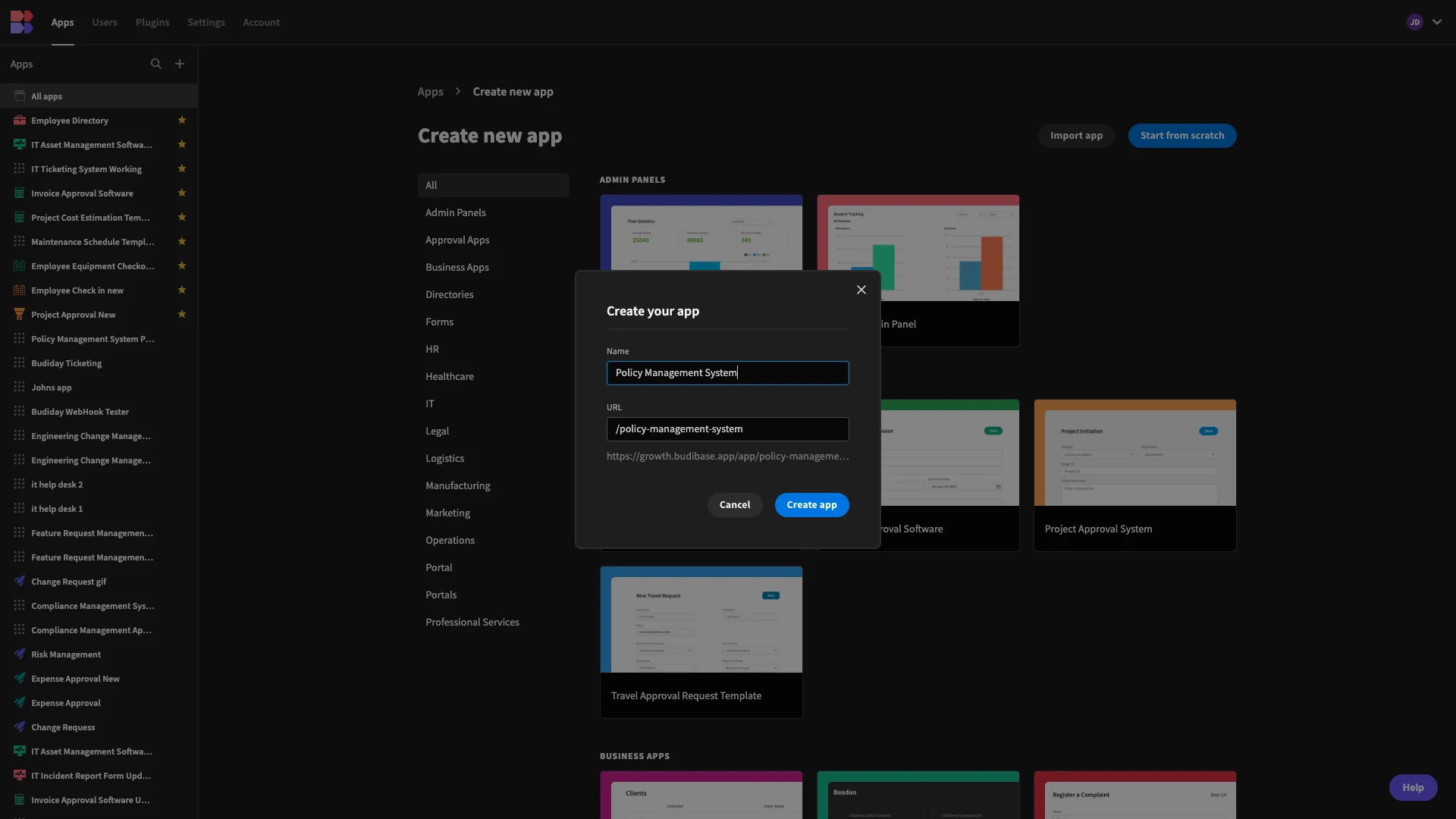
At this point, weÔÇÖre offered a range of data sources that we can connect our app to, including RDBMSs, NoSQL tools, APIs, spreadsheets, and more.
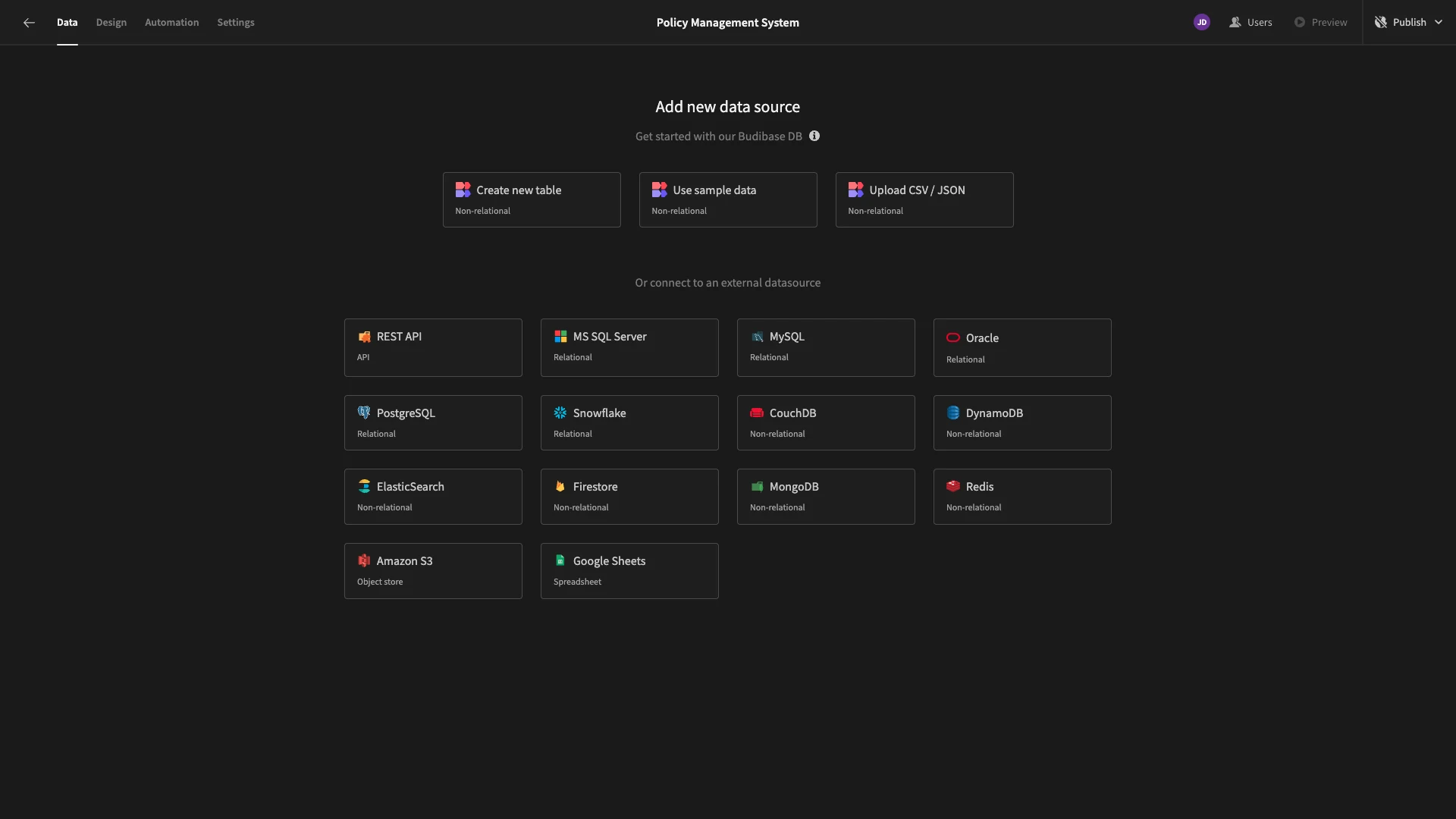
As we said earlier, weÔÇÖre using a PostgreSQL database. When we choose this option, weÔÇÖll be prompted to enter our connection details.
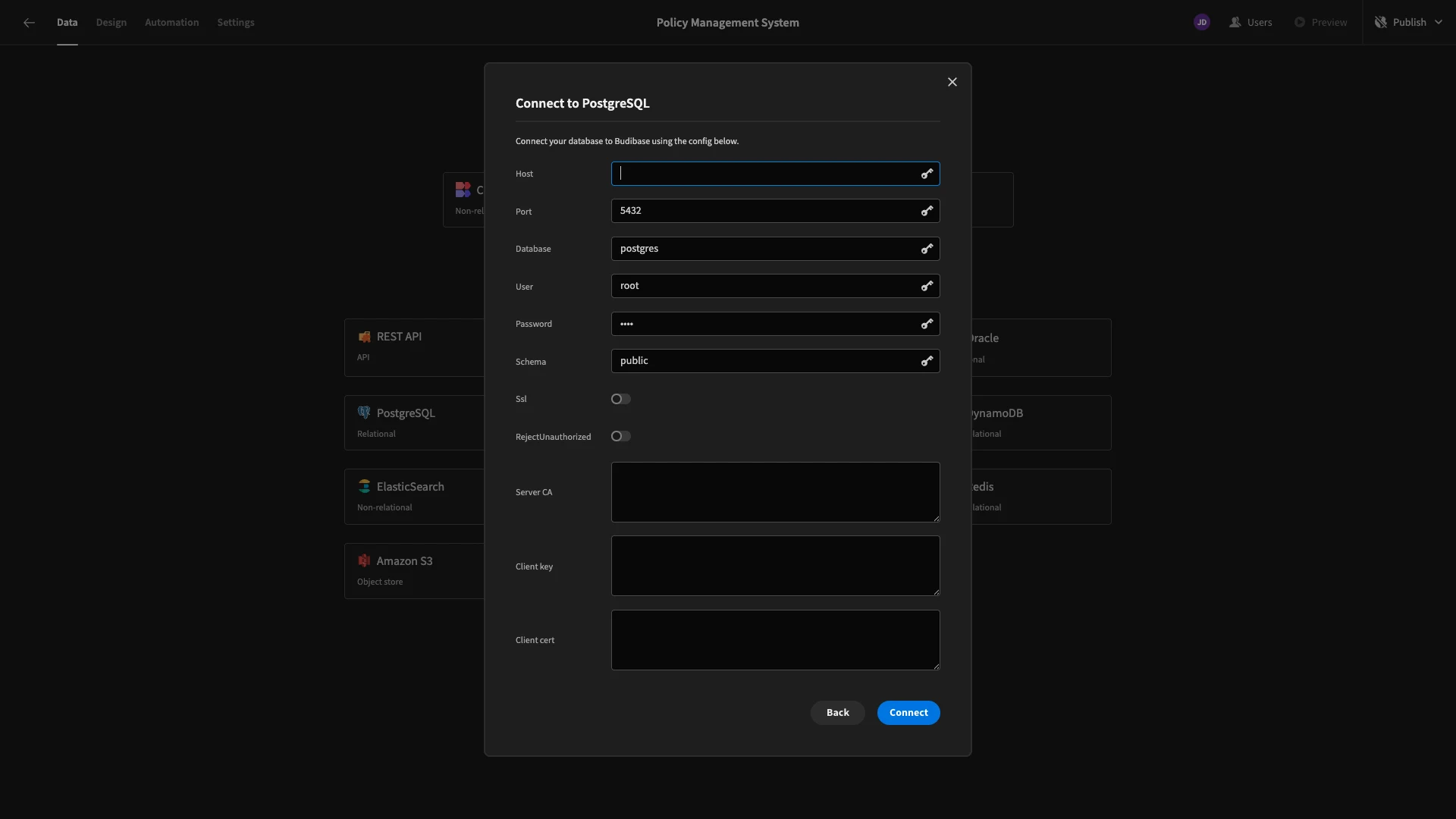
Then, weÔÇÖre offered a choice of which tables weÔÇÖd like to Fetch, making them queryable within ║┌┴¤ı²─▄┴┐. Our database has two tables called policies and policy_versions. WeÔÇÖre going to select both.
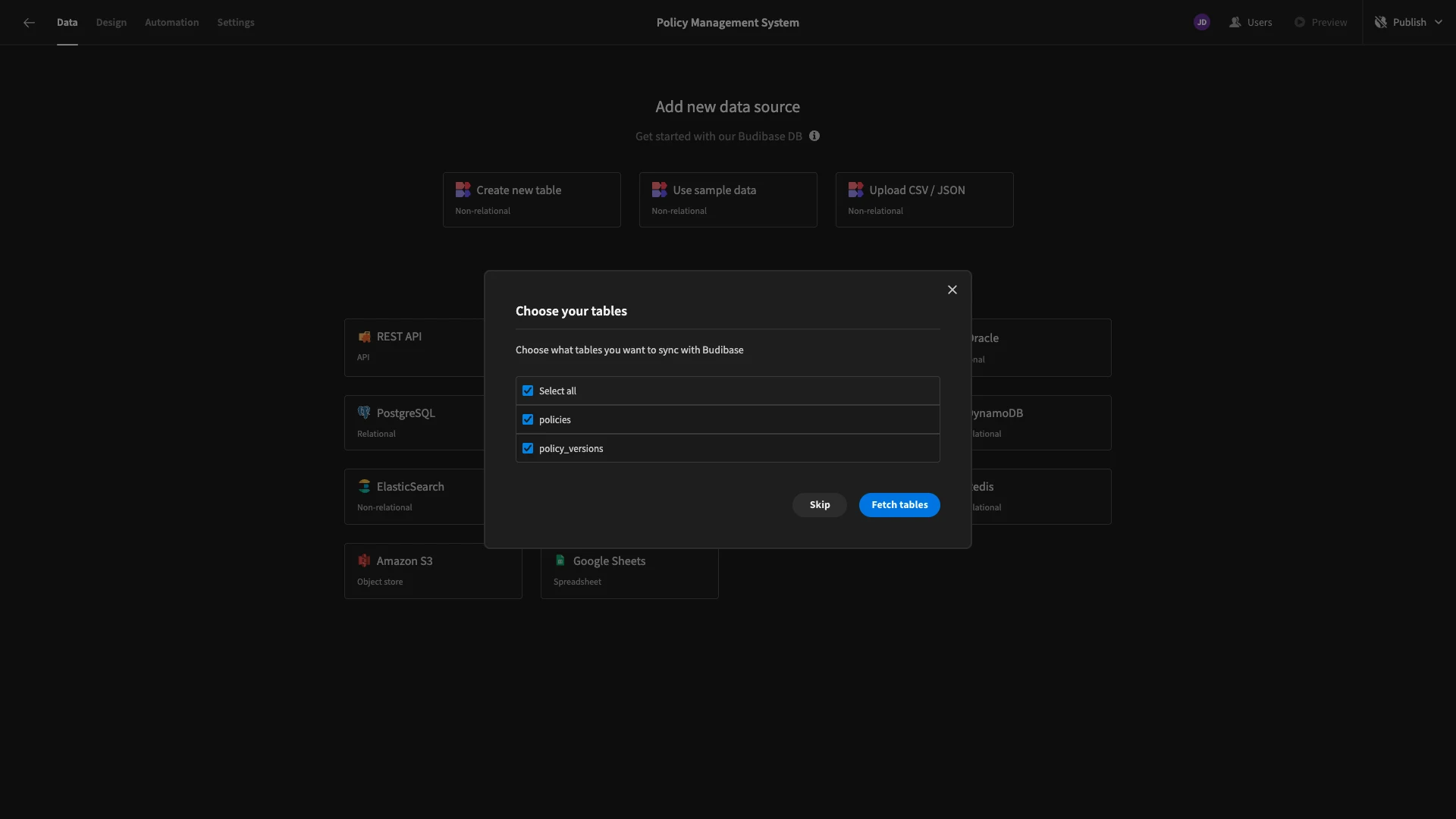
You can use the following query to create our tables:
1CREATE TABLE policies (
2
3 id SERIAL PRIMARY KEY,
4
5 title TEXT UNIQUE,
6
7 description TEXT,
8
9 category TEXT,
10
11 status TEXT CHECK (status IN ('Active', 'Archived')),
12
13 created_at TIMESTAMP DEFAULT NOW(),
14
15 updated_at TIMESTAMP DEFAULT NOW()
16
17);
18
19CREATE TABLE policy_versions (
20
21 id SERIAL PRIMARY KEY,
22
23 policy_id INTEGER REFERENCES policies(id) ON DELETE CASCADE,
24
25 title TEXT,
26
27 description TEXT,
28
29 category TEXT,
30
31 status TEXT CHECK (status IN ('Draft', 'Pending Approval', 'Approved', 'Rejected', 'Archived')),
32
33 created_at TIMESTAMP DEFAULT NOW(),
34
35 updated_at TIMESTAMP DEFAULT NOW()
36
37);You can populate these with:
1-- Insert Active Policy
2
3INSERT INTO policies (title, description, category, status)
4
5VALUES
6
7 ('IT Security Policy', 'Defines security standards for IT systems', 'Security', 'Active'),
8
9 ('Employee Conduct Policy', 'Guidelines for employee behavior and ethics', 'Human Resources', 'Archived'),
10
11 ('Data Privacy Policy', 'Outlines data handling and privacy practices', 'Compliance', 'Active');
12
13-- Insert Draft Policy Versions
14
15INSERT INTO policy_versions (policy_id, title, description, category, status)
16
17VALUES
18
19 (1, 'IT Security Policy', 'Initial draft of IT security policy', 'Security', 'Draft'),
20
21 (2, 'Employee Conduct Policy', 'Initial draft of employee conduct policy', 'Human Resources', 'Draft'),
22
23 (3, 'Data Privacy Policy', 'Initial draft of data privacy policy', 'Compliance', 'Draft');
24
25-- Insert Pending Approval Policy Versions
26
27INSERT INTO policy_versions (policy_id, title, description, category, status)
28
29VALUES
30
31 (1, 'IT Security Policy', 'Reviewed IT security policy draft', 'Security', 'Pending Approval'),
32
33 (2, 'Employee Conduct Policy', 'Updated draft of employee conduct policy', 'Human Resources', 'Pending Approval');
34
35-- Insert Approved Policy Versions
36
37INSERT INTO policy_versions (policy_id, title, description, category, status)
38
39VALUES
40
41 (1, 'IT Security Policy', 'Final version of IT security policy', 'Security', 'Approved'),
42
43 (3, 'Data Privacy Policy', 'Final version of data privacy policy', 'Compliance', 'Approved');
44
45-- Insert Rejected Policy Versions
46
47INSERT INTO policy_versions (policy_id, title, description, category, status)
48
49VALUES
50
51 (2, 'Employee Conduct Policy', 'Rejected version of employee conduct policy', 'Human Resources', 'Rejected');HereÔÇÖs how our policies table looks in ║┌┴¤ı²─▄┴┐ÔÇÖs Data section once weÔÇÖve Fetched it.

Altering existing columns
In ║┌┴¤ı²─▄┴┐, we can make adjustments within the Data section that will then be reflected when we start generating UIs and automations.
Firstly, all of our TEXT columns are handled the same way in our database, but ║┌┴¤ı²─▄┴┐ distinguishes between a few types of textual data. Each database table has a field called description.
WeÔÇÖll change these from Text to Long Form Text. Remember to repeat this process on both tables.
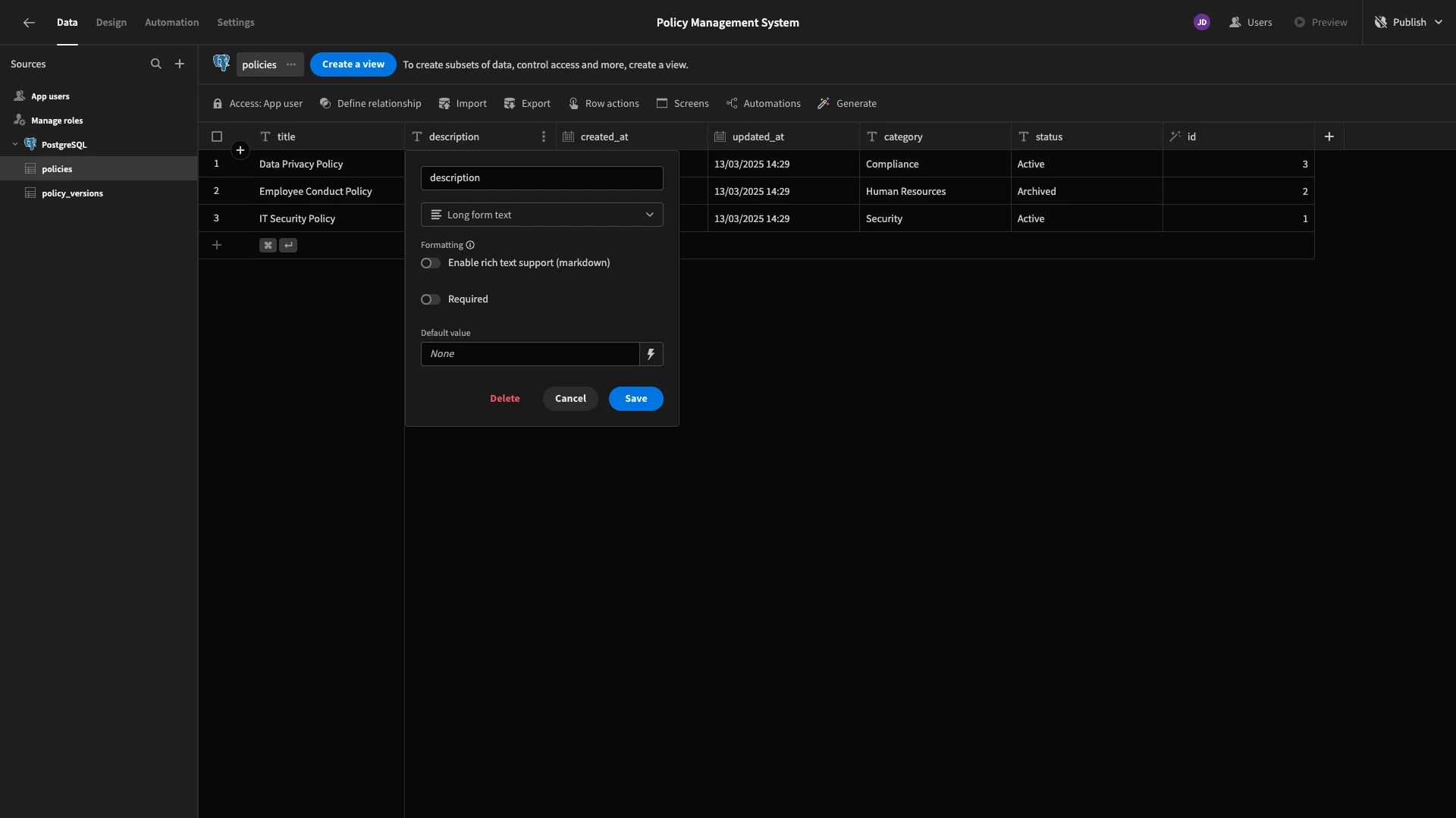
Next, our tables have a few attributes that we only want to offer defined options for. These are the status and category columns on each table. Our possible categories will be Security, Human Resources, and Compliance, although you could add more to suit your needs.

WeÔÇÖll change the type for these columns to Single Select and input these options. Again, remember to do this for both tables.
The status in each of our tables will have different options. On the policies table, these will be Active and Archived.

For policy_versions, weÔÇÖll use Draft, Pending Approval, Approved, and Rejected.
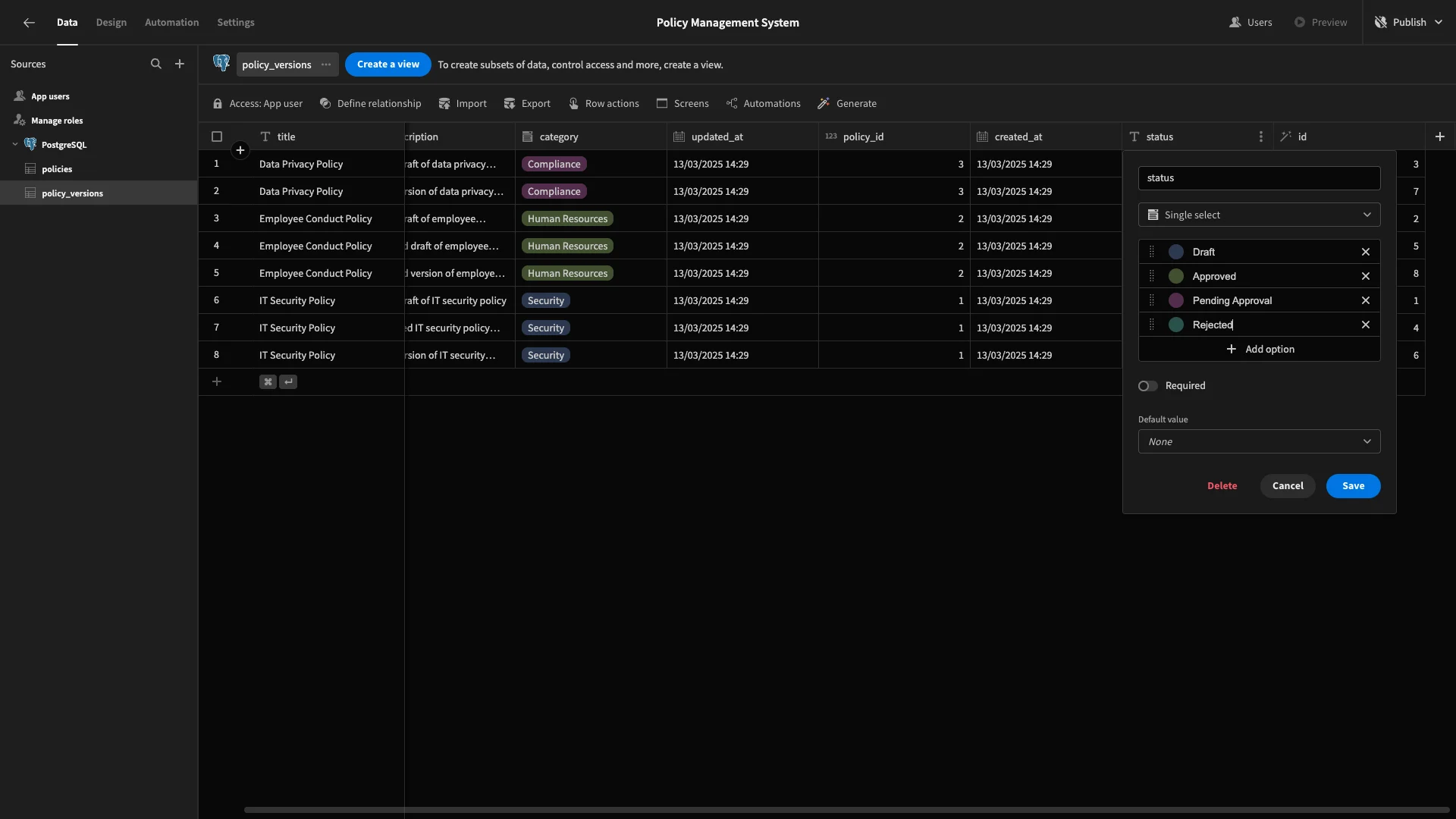
Default values
We can also add Default Values within the Data layer. These will be used as a fallback when a row is created if a value isnÔÇÖt specified for a particular column. WeÔÇÖre going to add these across all of our statuses and dates on both tables.
WeÔÇÖll start with the statusattributes, using the options picker in their settings. On policies, weÔÇÖll default to Active.
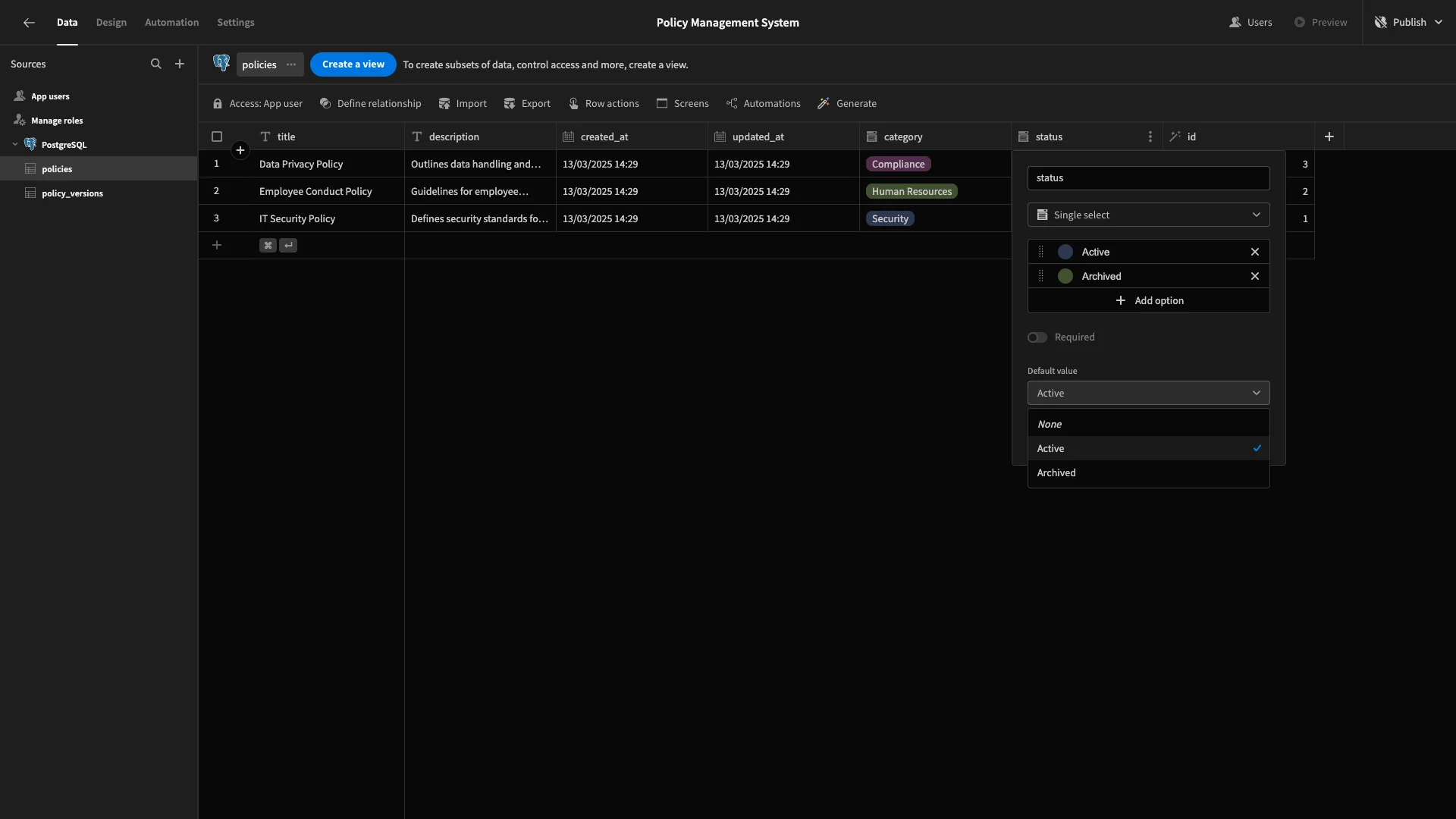
WeÔÇÖll repeat this same process to set the default status for our policy_versions table to Pending Approval.
Next, each of our tables contains columns called created_at and updated_at. We want both of these to be populated with the current date and time when a row is created, so weÔÇÖll bind their default values to {{ Date }}.
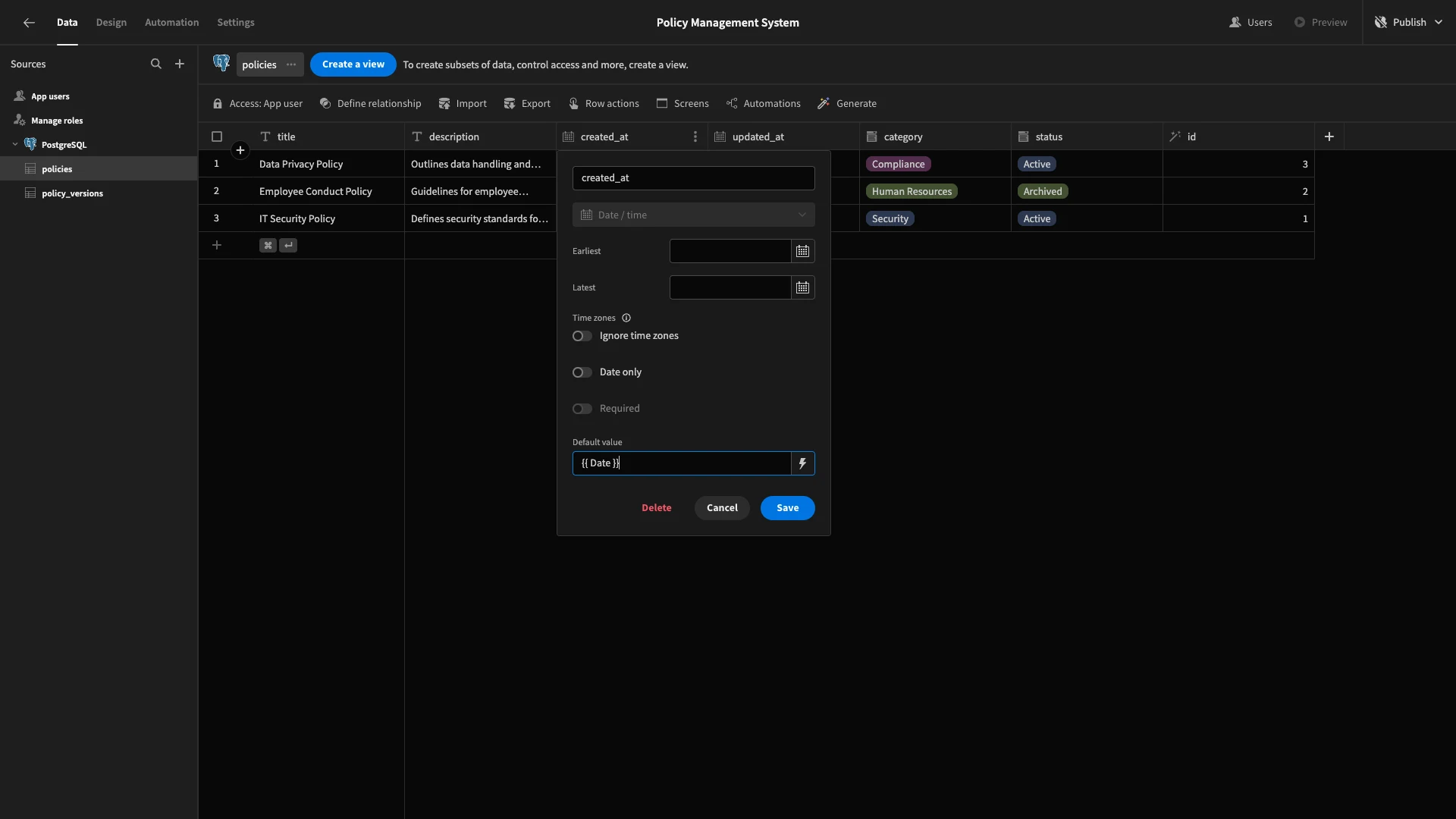
Again, make sure to repeat this process across both date columns in each of our tables.
Configuring relationships and user columns
Our tables already have the data we need to denote relationships. Each one has a unique id attribute. The policy_id attribute under policy_versions then corresponds to the id attribute in the policies table.
We just need to configure this in ║┌┴¤ı²─▄┴┐.
Start by hitting Define Relationship.
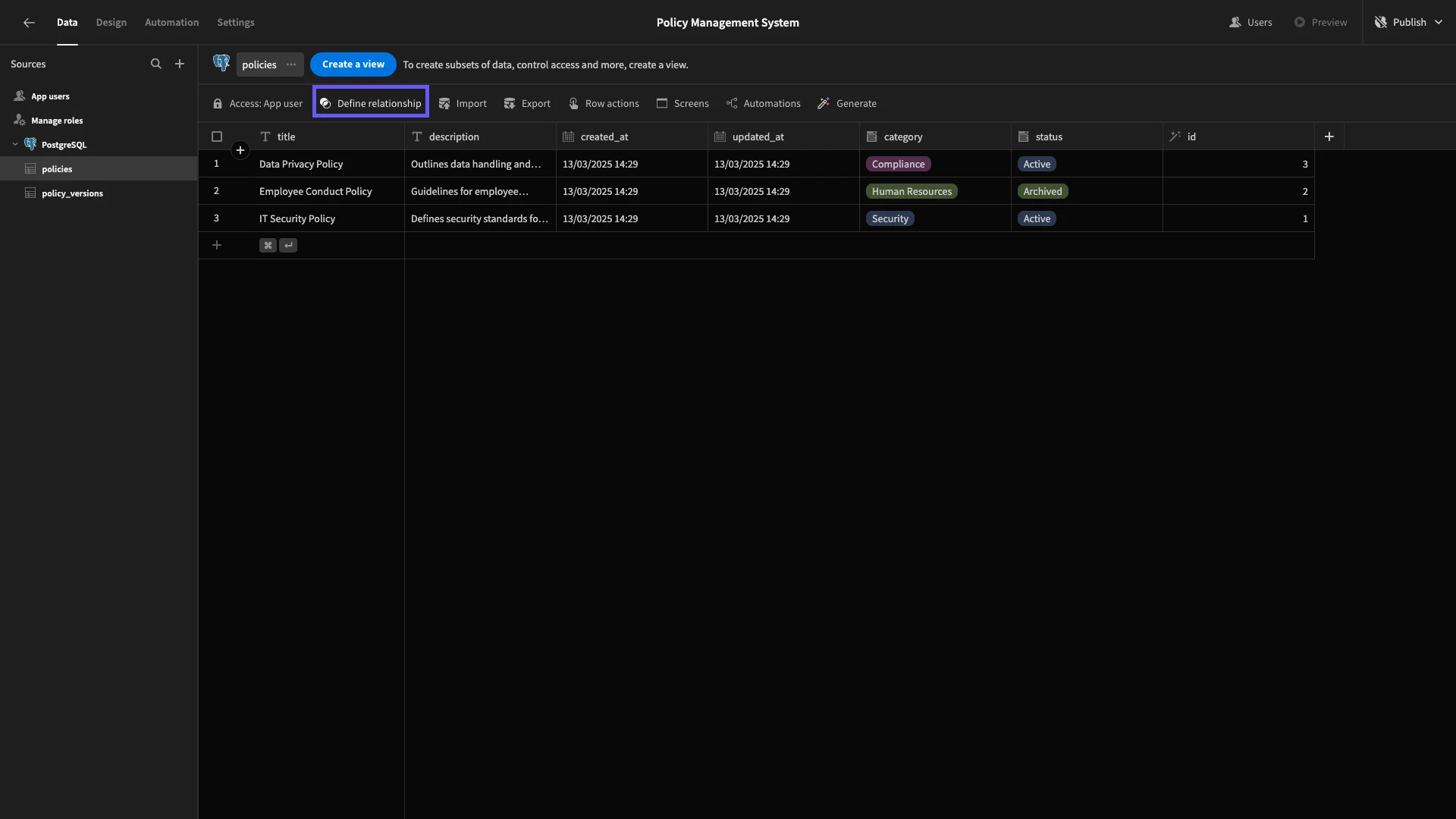
WeÔÇÖre then presented with this modal, where we can set up our relationship.
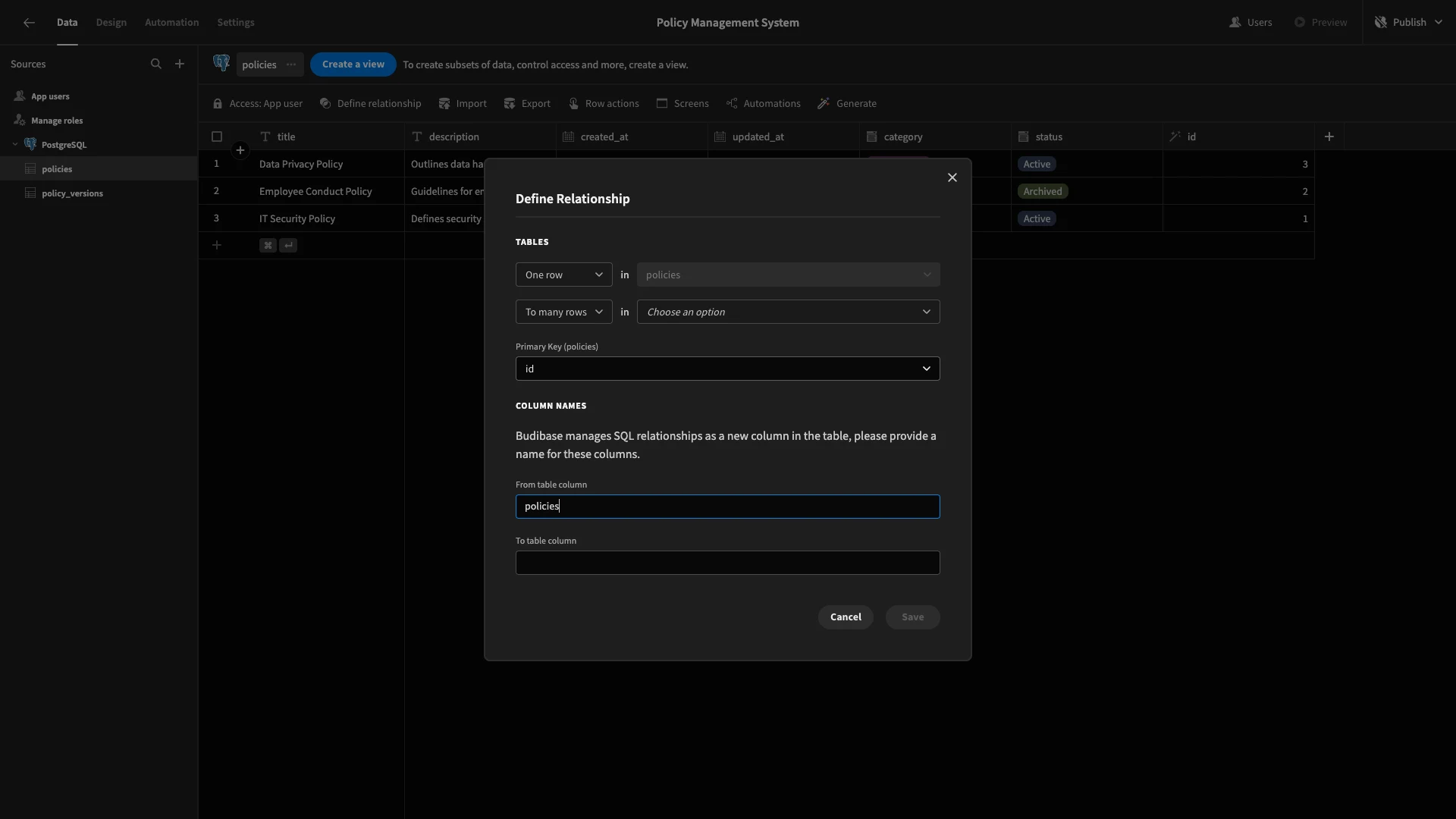
WeÔÇÖre going to set this so that one row in the policies table links to many rows on policy_versions, using id as our primary key and policy_id as our foreign key.
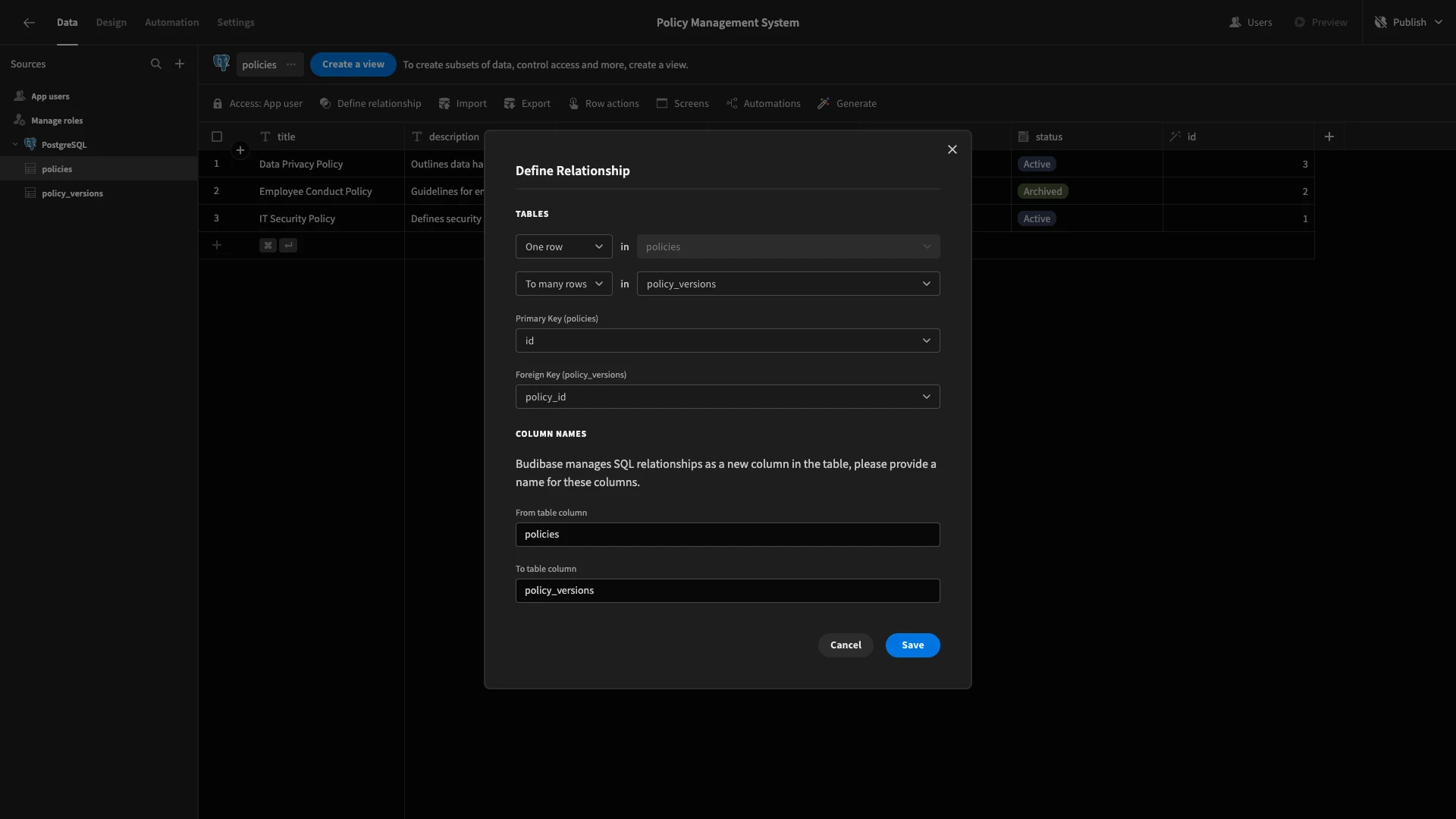
Now, we can see related rows across each of our tables.

We also want the ability to link rows on our policy_versions table to specific users, but this works a little bit differently since weÔÇÖre dealing with ║┌┴¤ı²─▄┴┐ÔÇÖs internal Users table.
We offer two special data types for this, depending on whether we want to relate rows to one user or many.
WeÔÇÖre going to add two Single User columns to our policy_versions table. The first will be called editor. WeÔÇÖre also enabling the option to default to current user.

WeÔÇÖll then add a second Single User column and call it approver. This time, we donÔÇÖt need a default value.
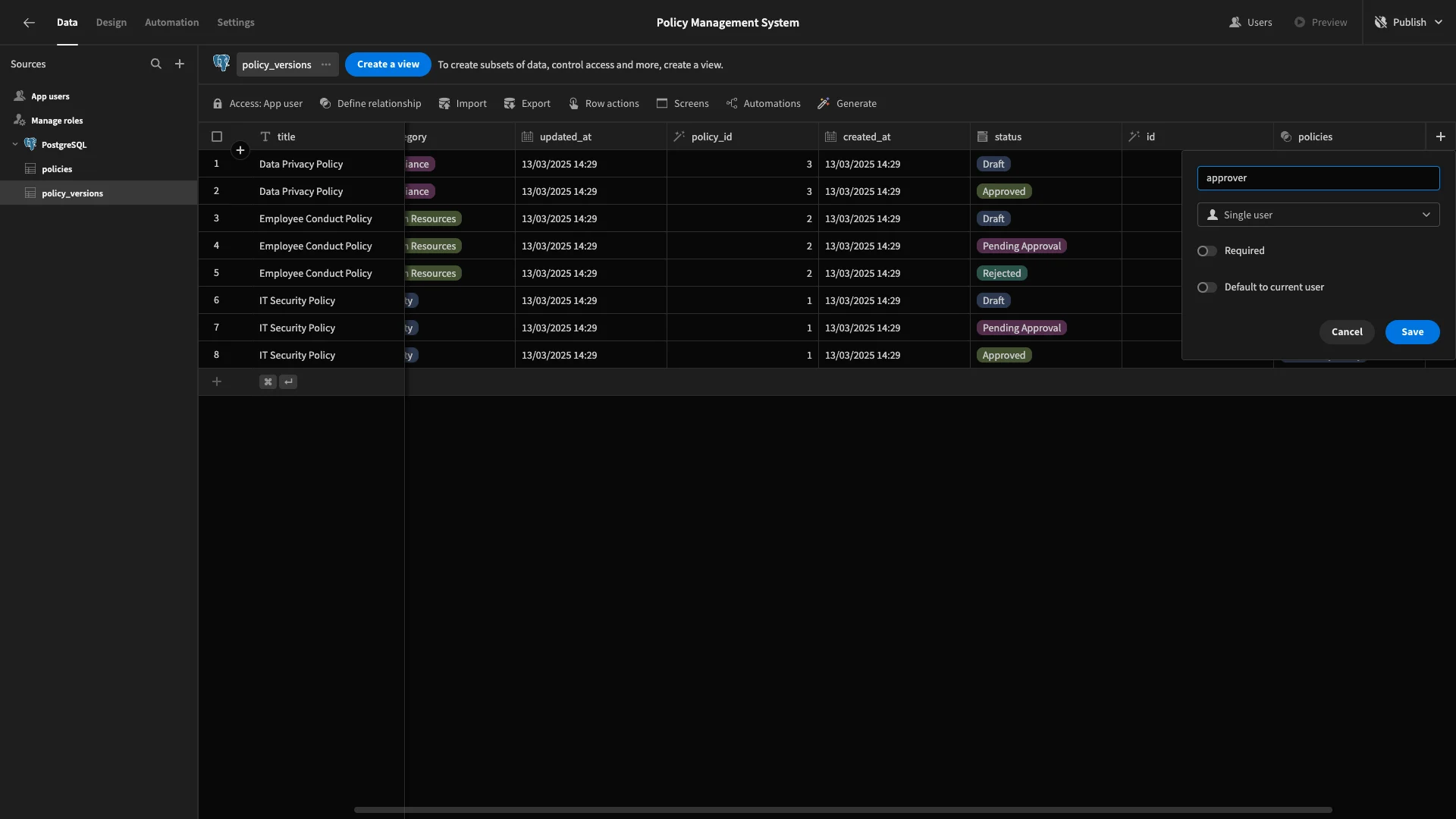
Adding user roles
Before we go any further, weÔÇÖll need to set up our policy management systemÔÇÖs access roles. As we outlined earlier, weÔÇÖll have two roles called editor and approver, who can submit and approve new policy versions, respectively.
WeÔÇÖll start by hitting Manage Roles. This opens ║┌┴¤ı²─▄┴┐ÔÇÖs visual RBAC editor.
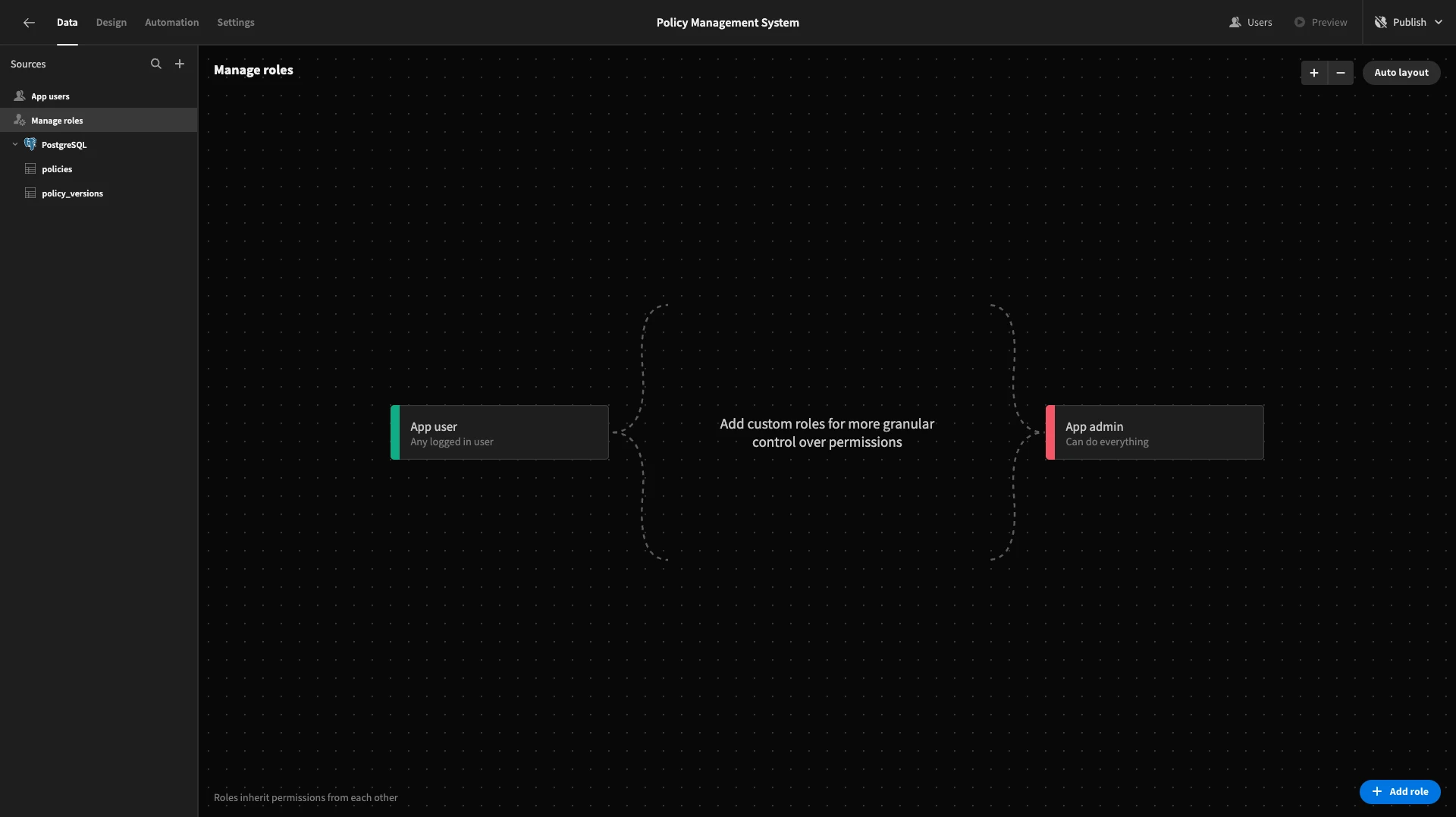
Here, we can configure our user roles. We can then assign permissions to these elsewhere in the builder.
WeÔÇÖll start by adding our two roles, editor and approver.

We want our approvers to inherit their permissions from editors. To do this, weÔÇÖll place editorto the left ofapprover` and draw a line between them to denote inheritance.
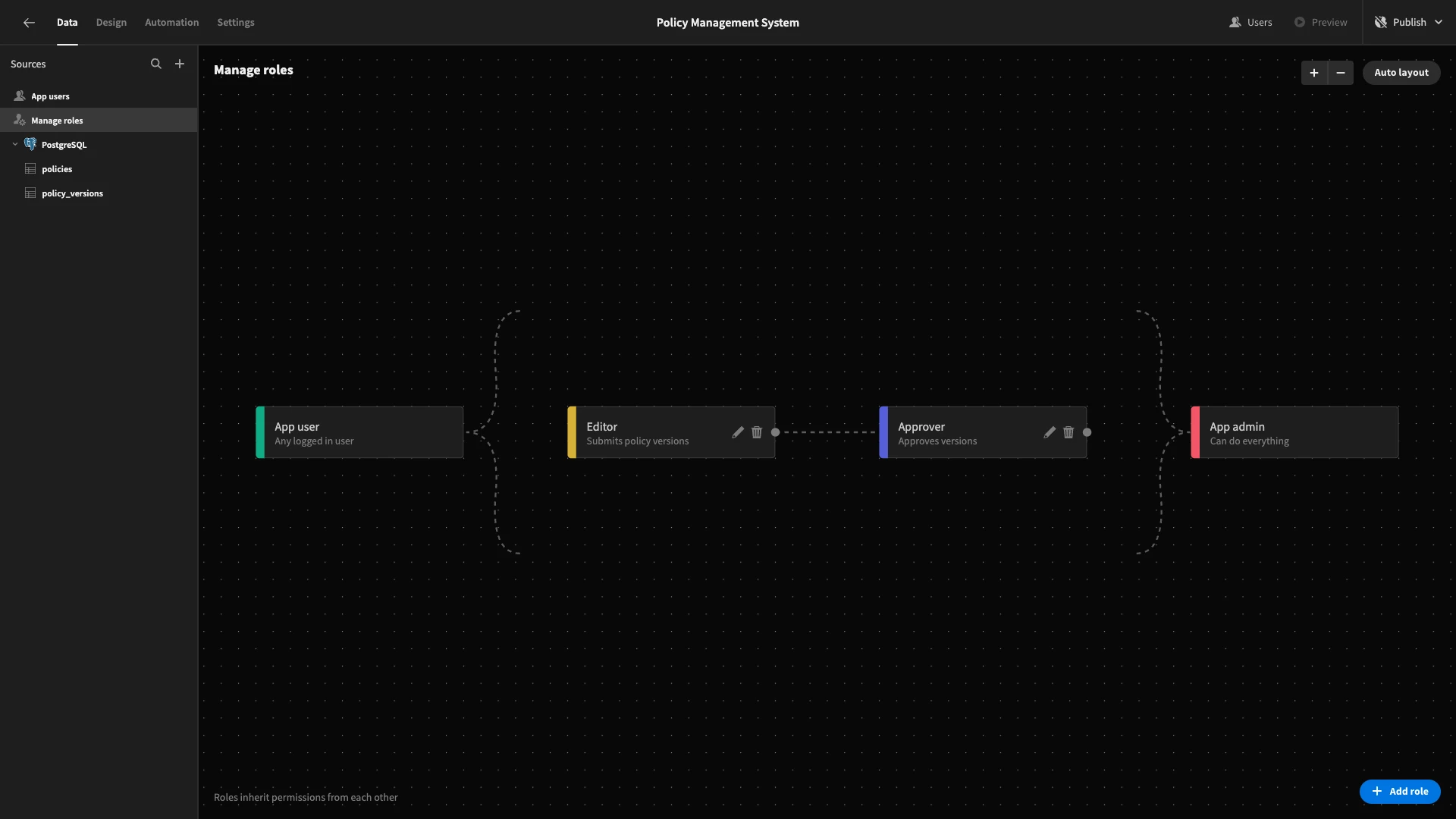
Building role-specific views
We can define what permissions weÔÇÖll give to users with each role without leaving the Data section.
That is, weÔÇÖre going to create database views based on each table that will define which read and write actions each role is granted.
The first thing we need to do is remove their permissions to perform full CRUD actions on the underlying tables. WeÔÇÖll do this by setting the Access for each table to App Admin, which is the highest user role.

WeÔÇÖll start by creating views for our policies table, as the permissions within these will be quite simple. Hit Create a View. WeÔÇÖll be presented with this modal, where we can give our new view a name.
WeÔÇÖll call this first one Editor Policies.
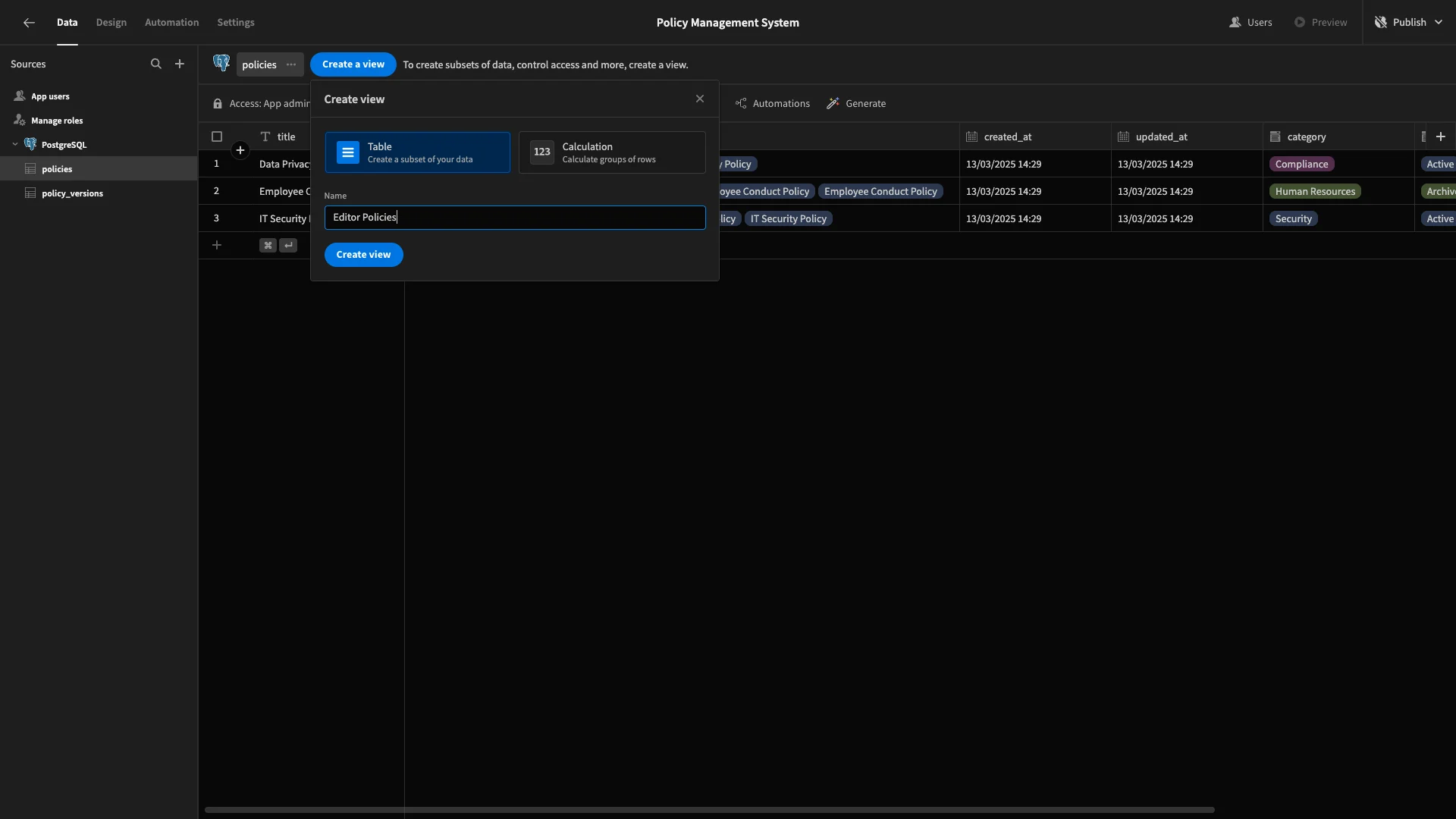
Then, weÔÇÖll set the Access to Editor.
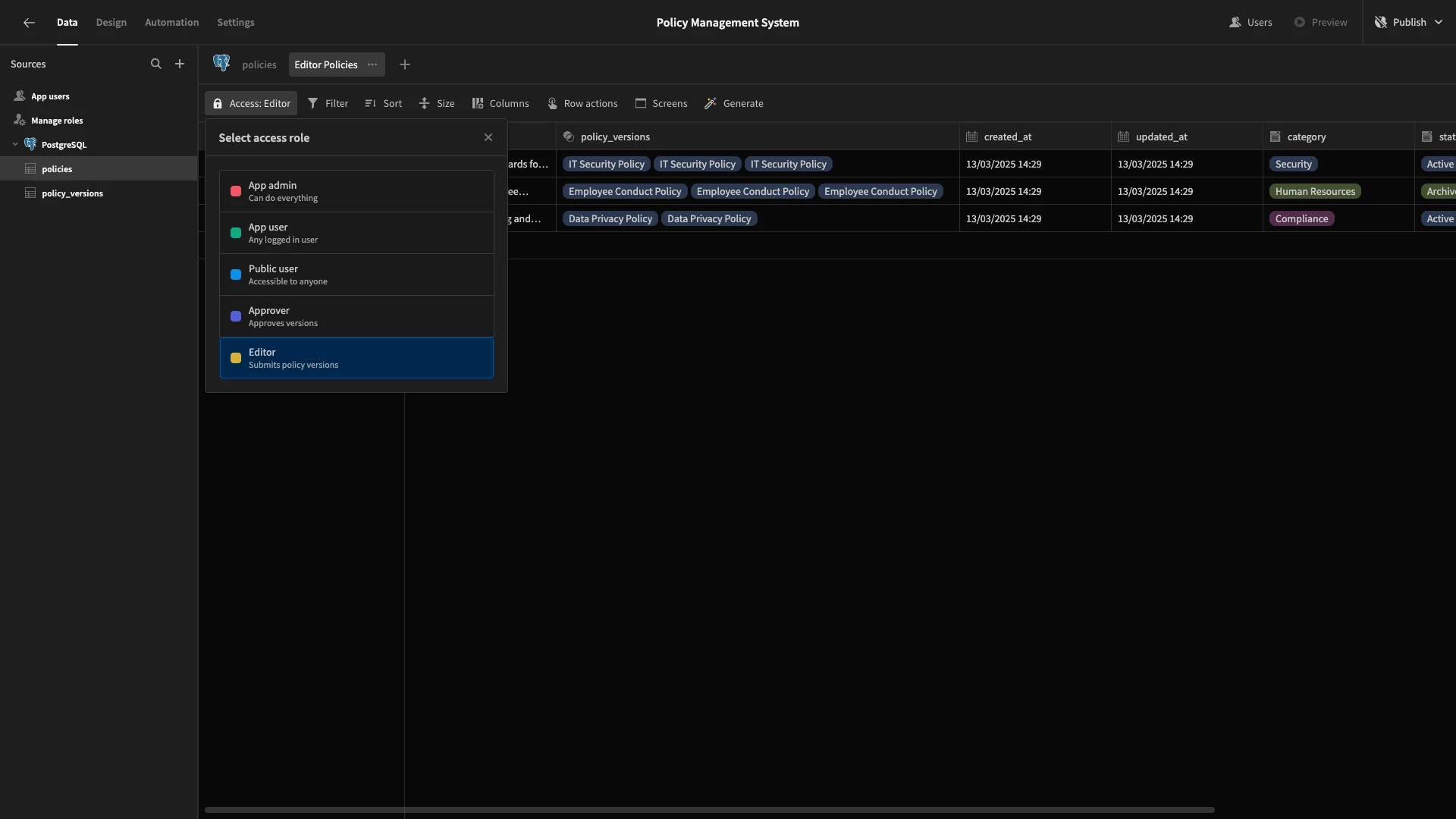
Then, under Columns, weÔÇÖll set everything to read-only.
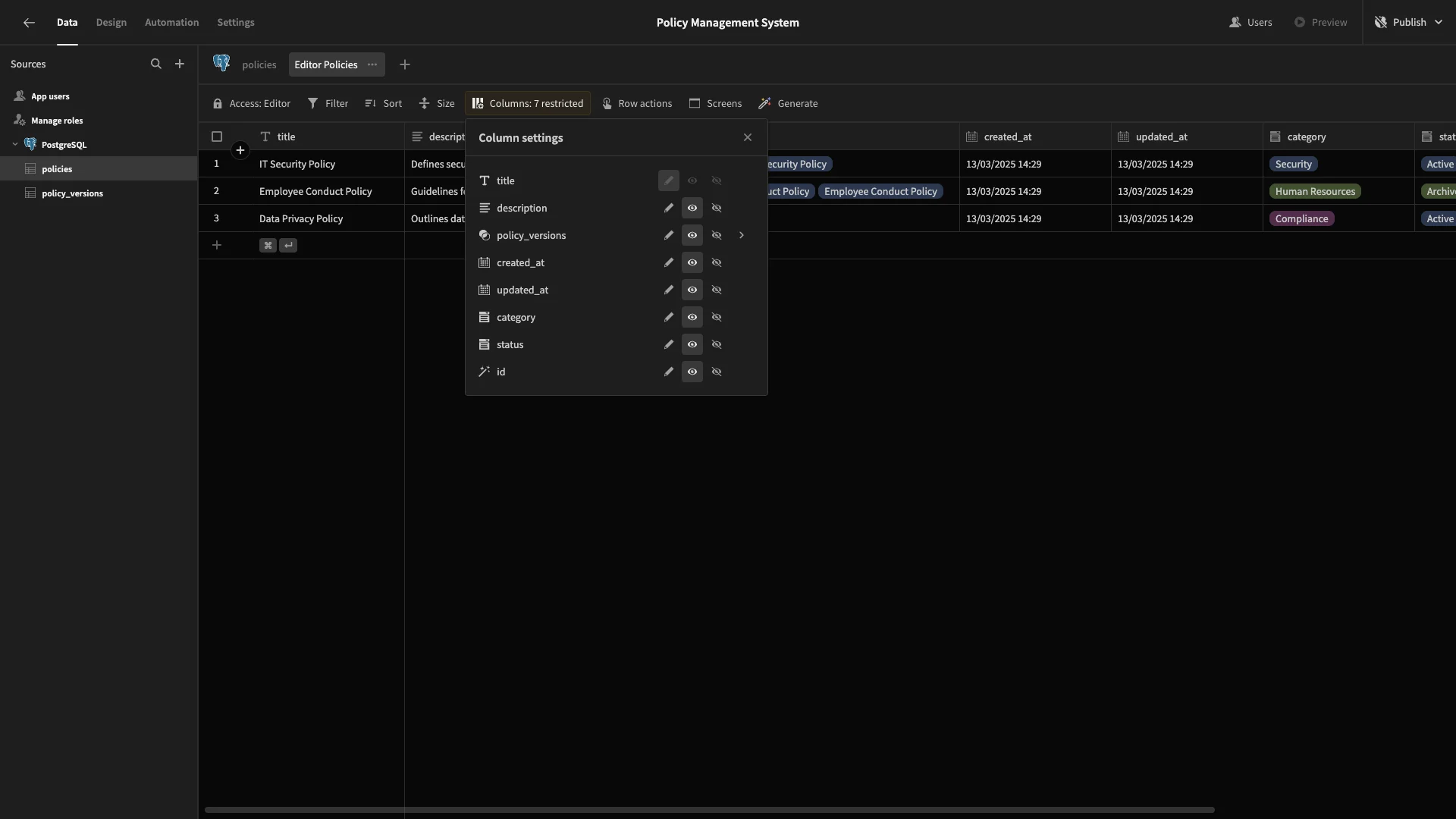
WeÔÇÖll repeat this process to make a second view called Approver Policies, setting its Access to Approver. This time, weÔÇÖll leave all columns readable, except updated_at, which weÔÇÖll make read-only.
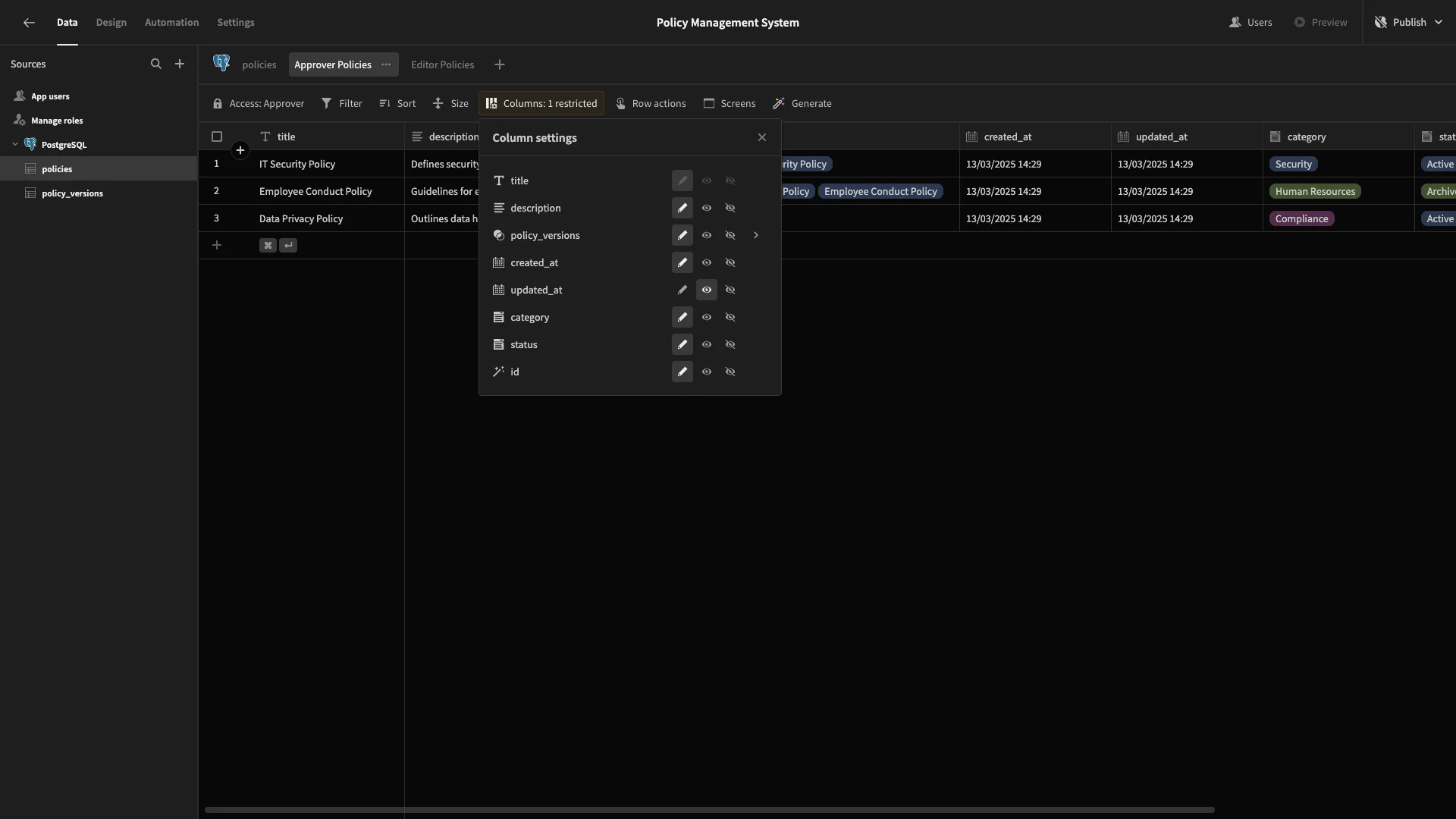
Next, weÔÇÖll create role-specific views for our policy_versions table.
WeÔÇÖll create one called Editor Versions, with the Access set to Editor. This time, weÔÇÖll set all columns except title, description, and category to read-only.

Finally, Approver Policies will have all columns set to read-only, except for status.
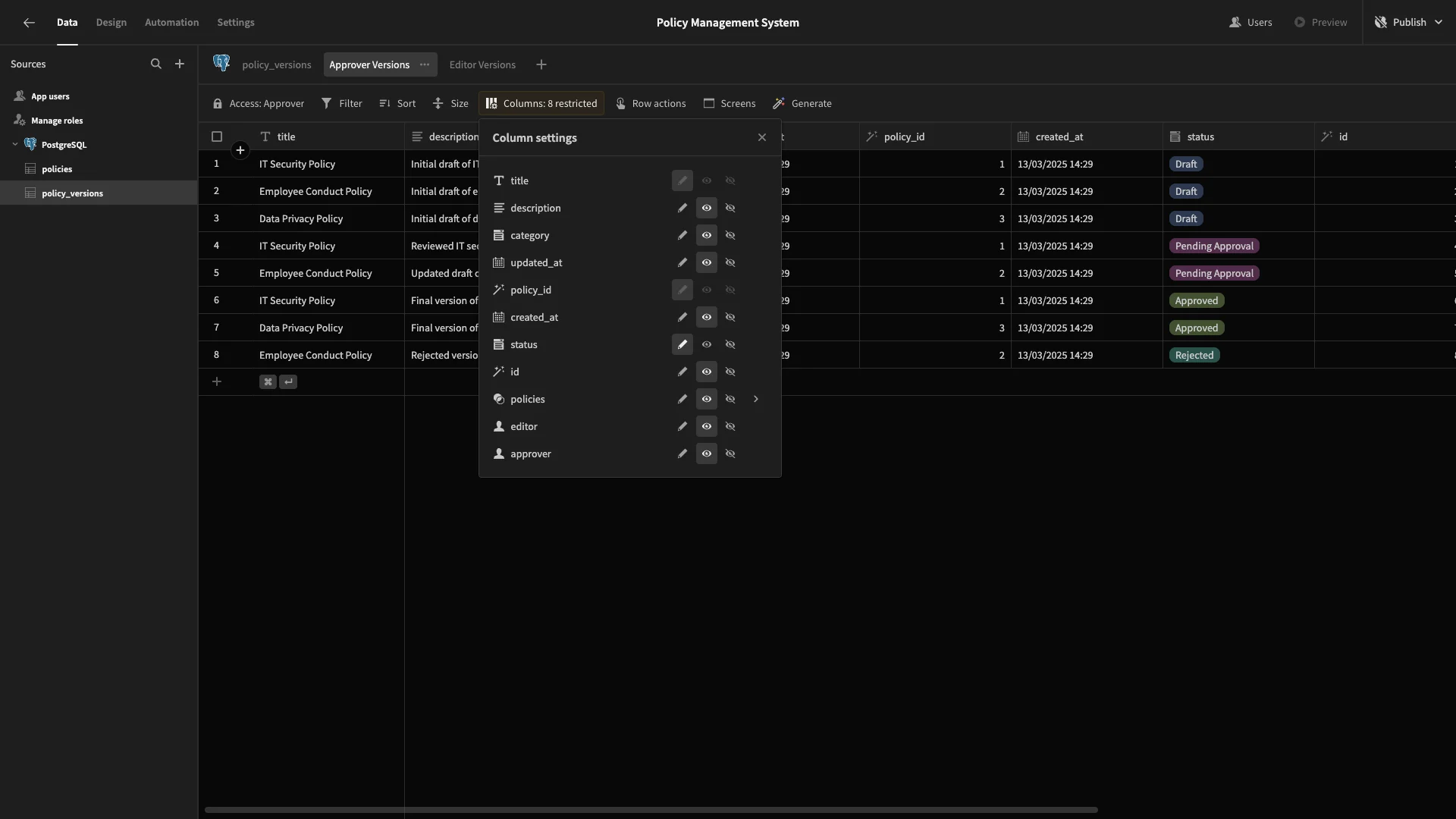
And thatÔÇÖs our data model ready to go. Now, we can start generating automation logic and UIs based on this.
2. Setting up approval logic
Our approval management system will rely heavily on a couple of automation rules. So, we want to build these before we start designing our app screens.
Archiving policies
First, weÔÇÖre going to set up a simple rule that will allow Approvers to set the status of policies to Archived with a button press. To do this, weÔÇÖll use a Row Action, which we can generate from the Data section.
Head to the Approver Policies view and hit Create row action.
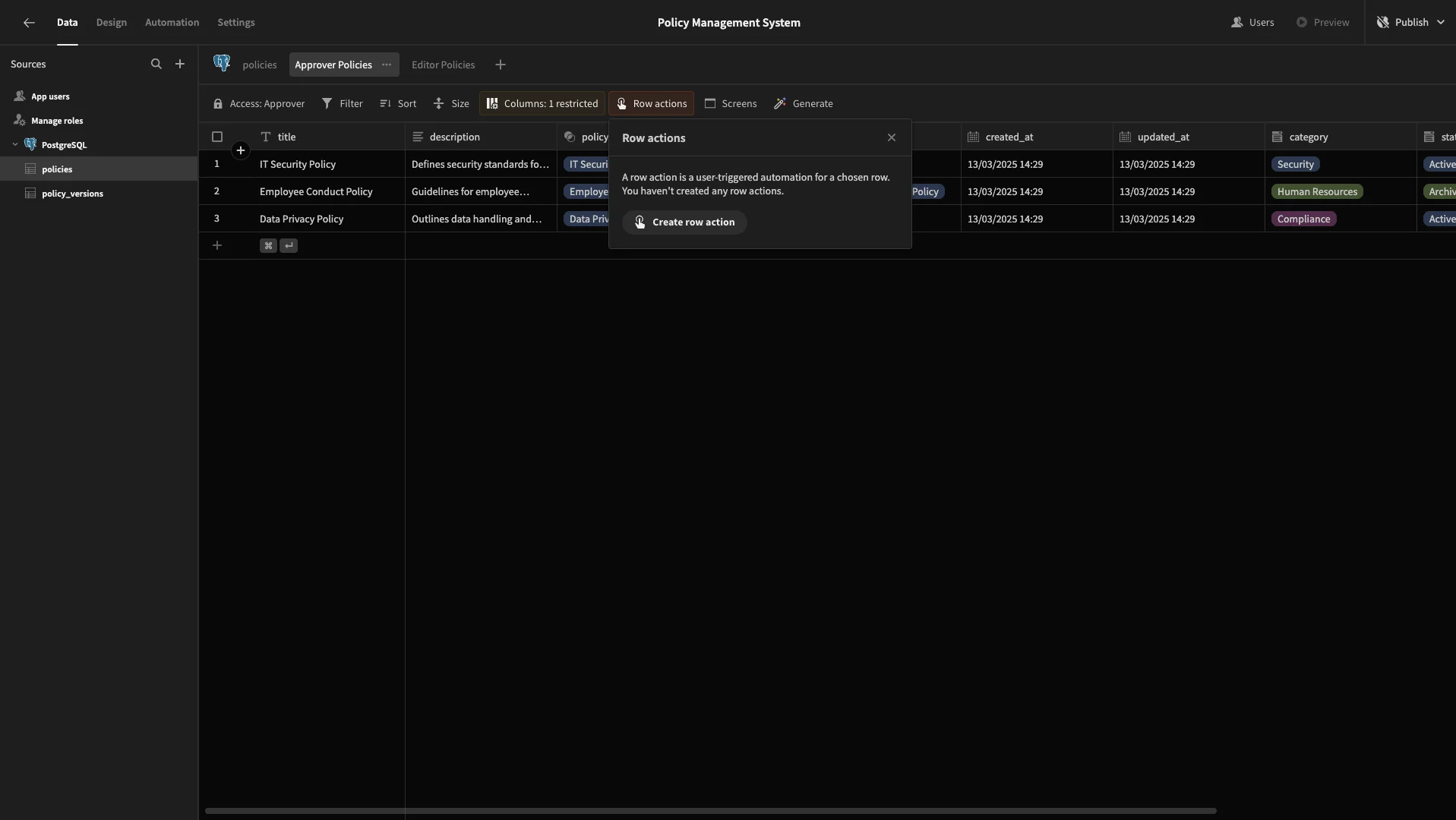
When prompted, weÔÇÖll call this Archive.
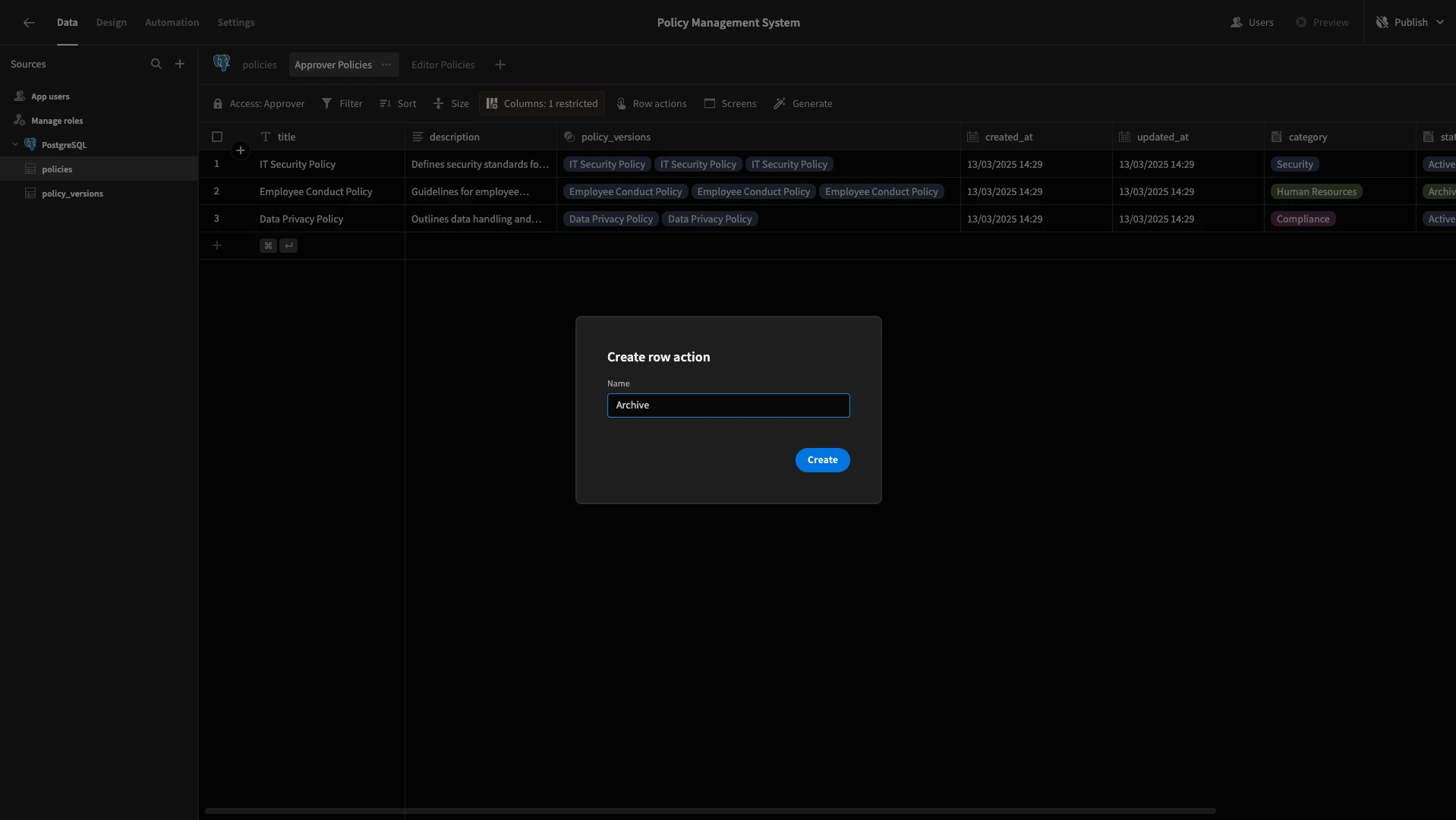
This creates an automation rule thatÔÇÖs triggered by user actions on a specific row from the front-end of your app.
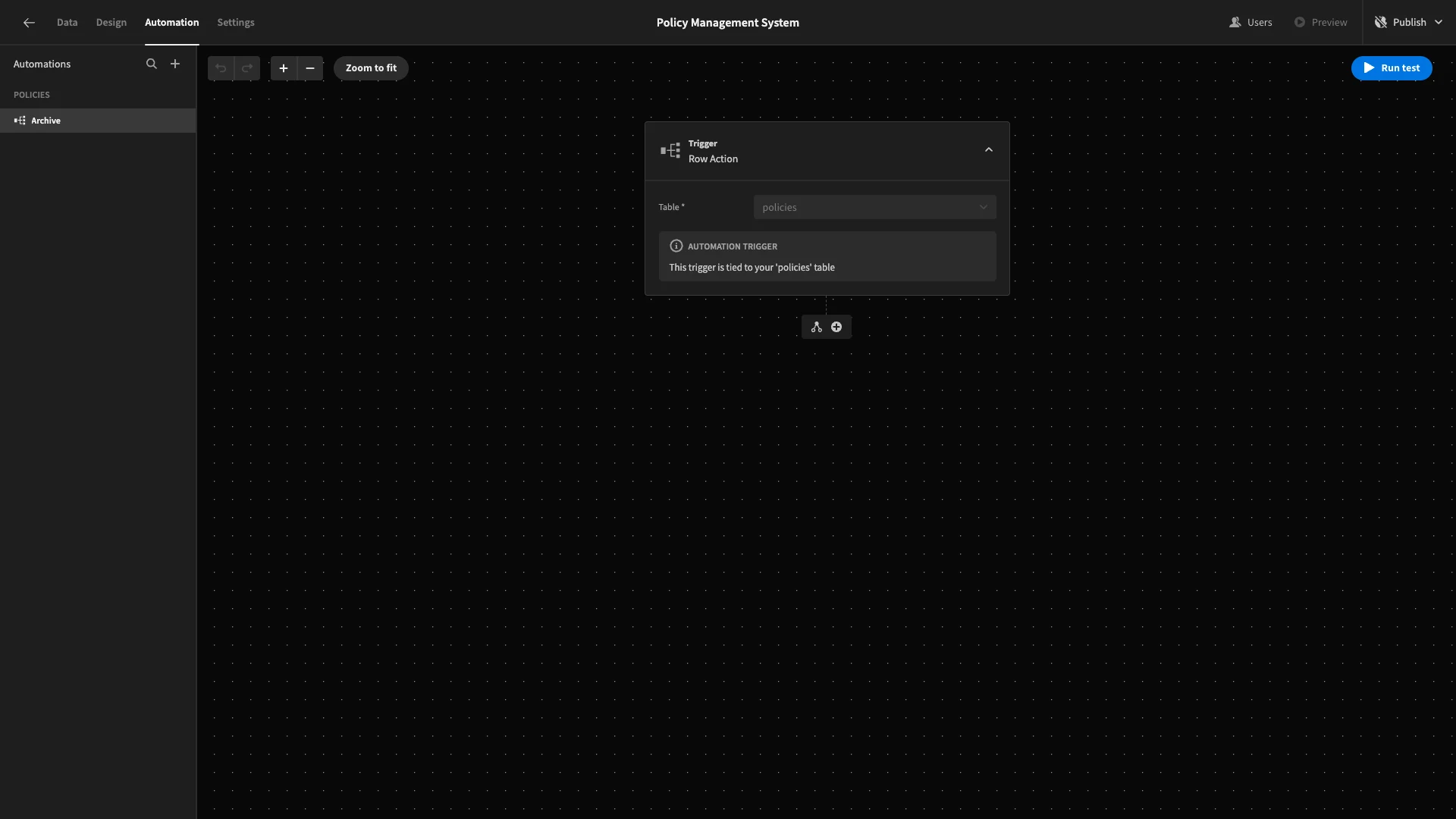
WeÔÇÖre going to add a single action step after our trigger. Hit the plus icon. Here, weÔÇÖll select Update Row.
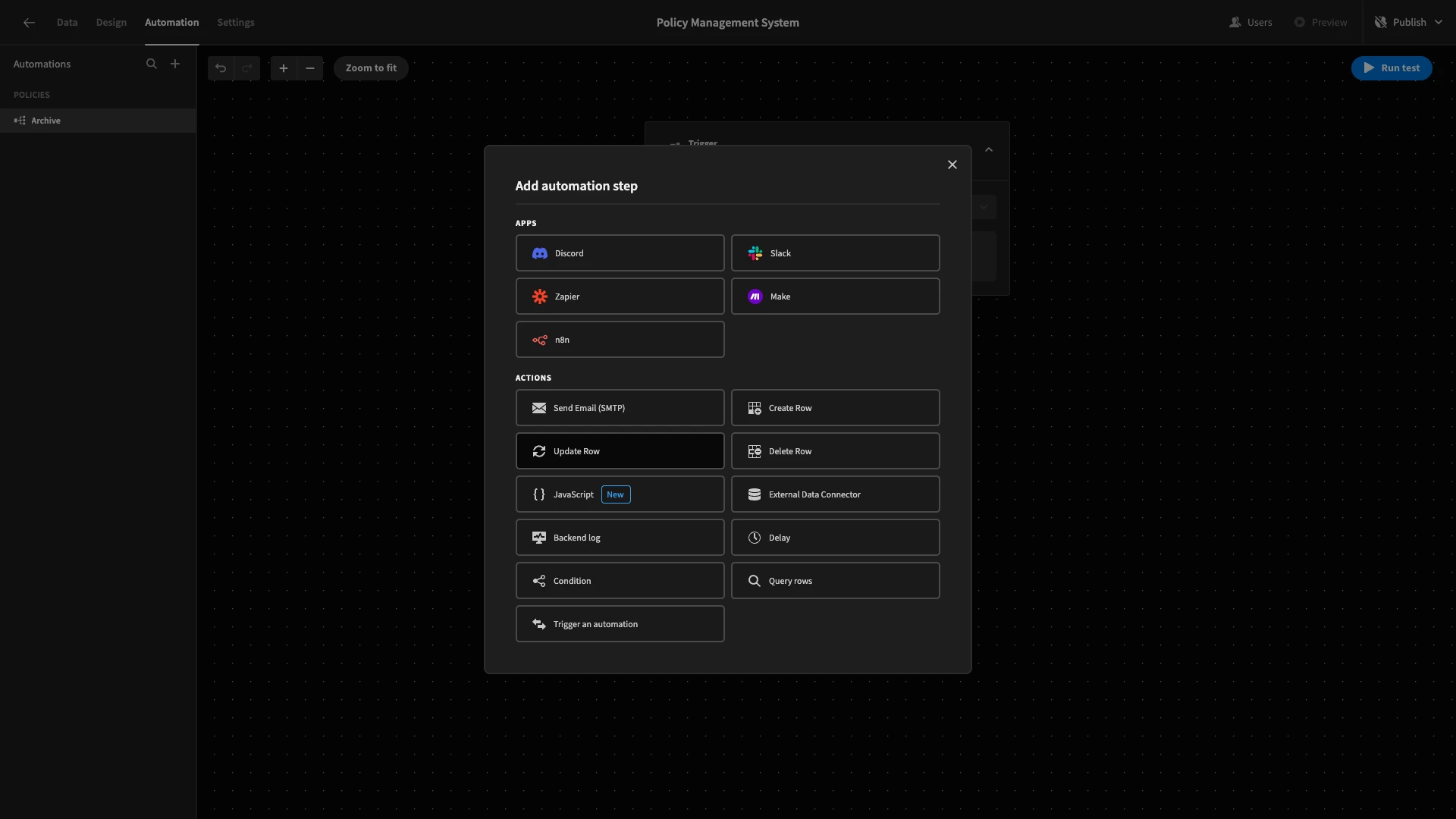
WeÔÇÖll set the Table to policies and hit the lightning bolt icon to open the bindings drawer for our Row ID.
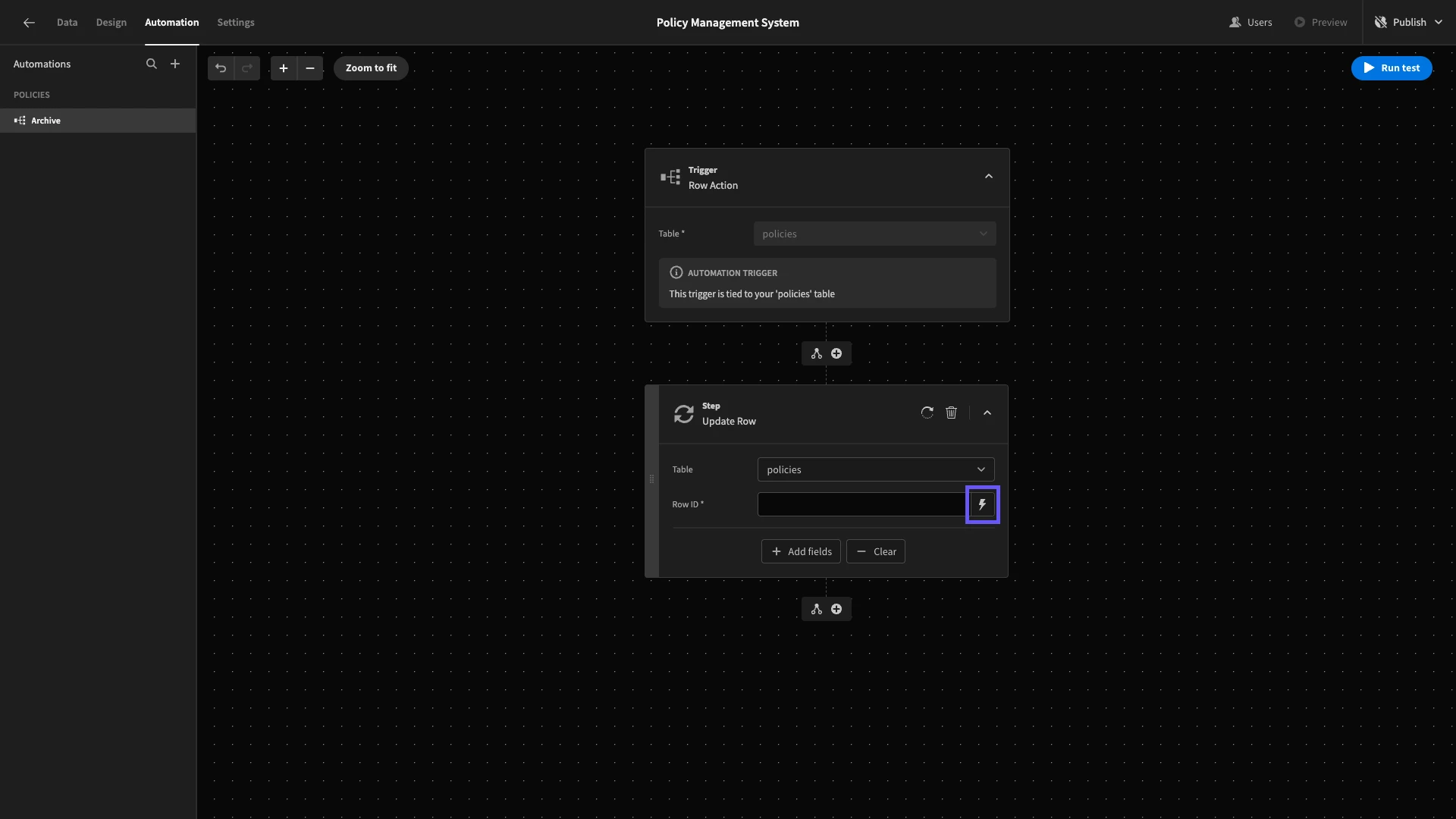
Under Trigger Outputs, weÔÇÖll choose id.
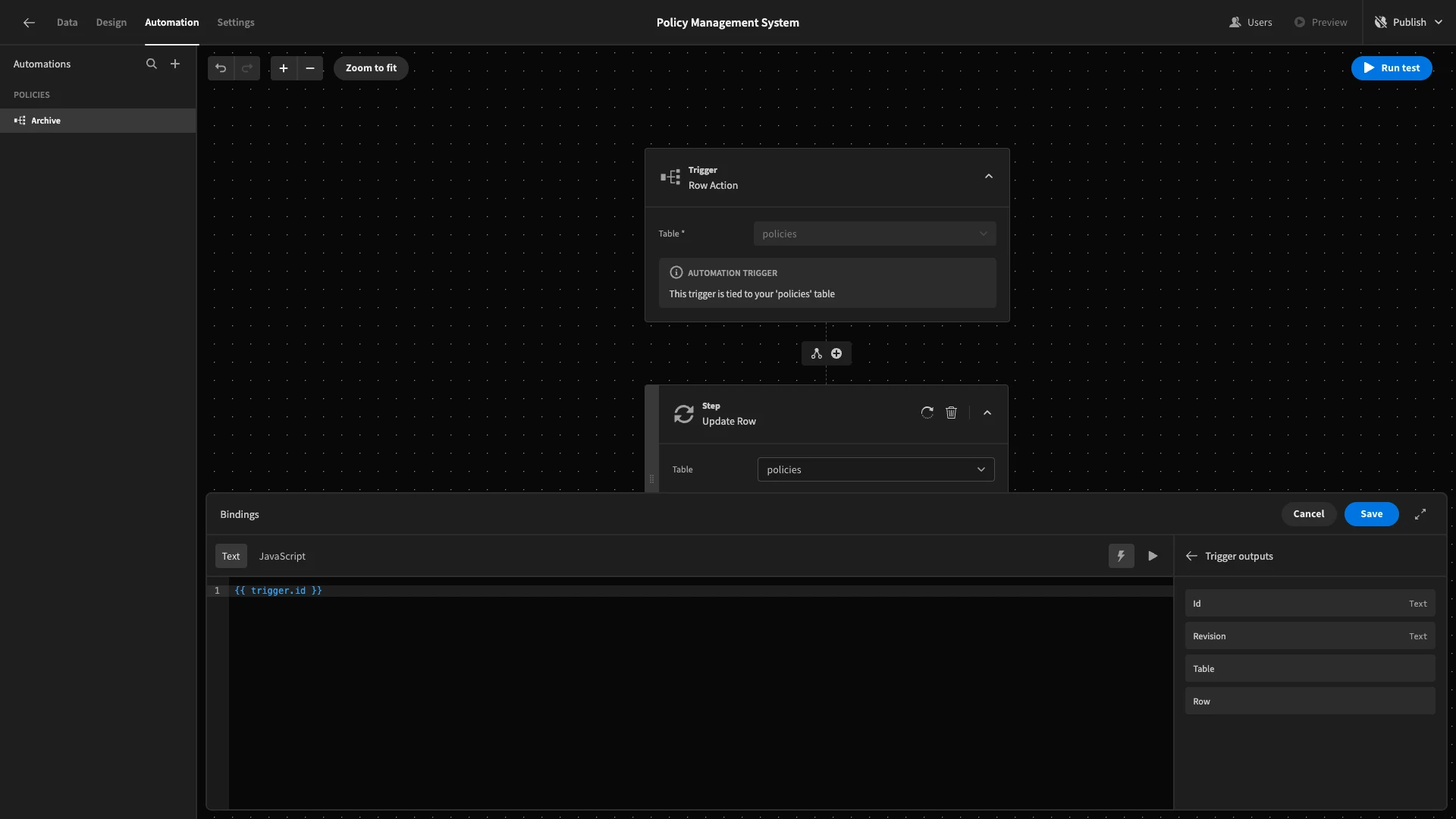
Now, the Update Row action will be taken on whichever row triggered our automation rule.
WeÔÇÖll use then add the status and updated_at fields.
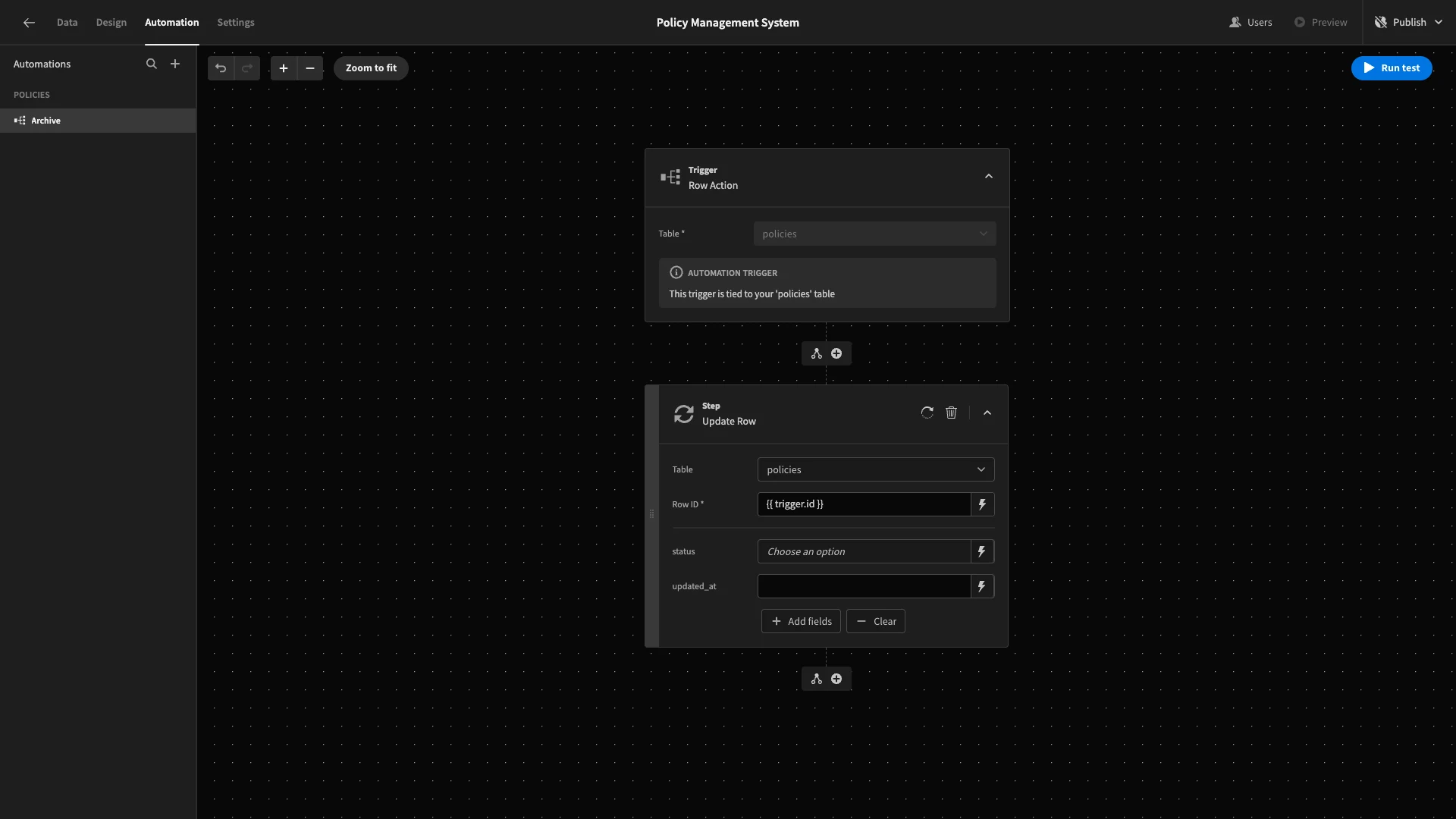
WeÔÇÖll set status to Archived as a static value. WeÔÇÖll then bind the updated_at column to {{ date now "" }}, setting the current timestamp.
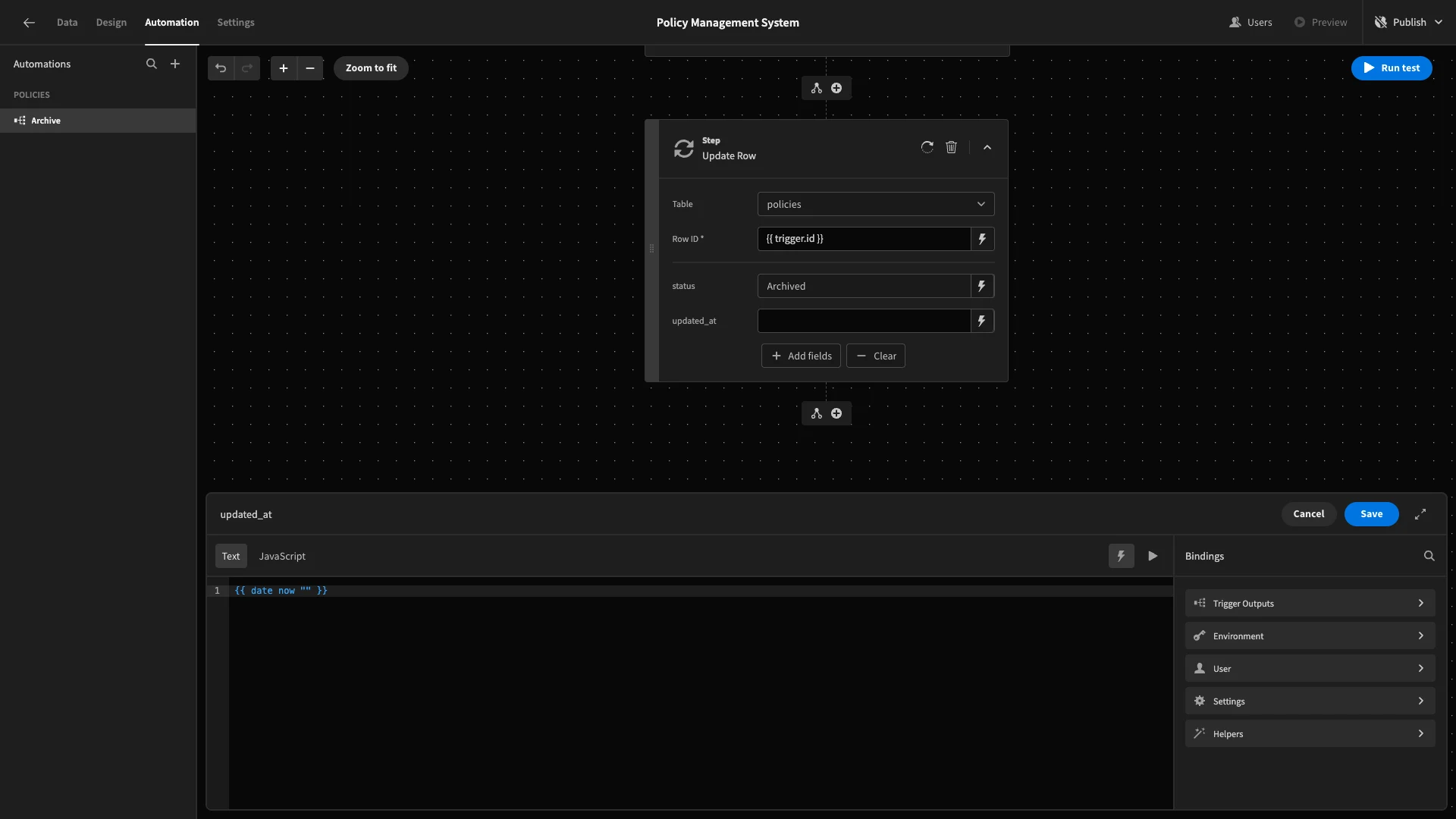
We can then hit Run Test to confirm that this works.
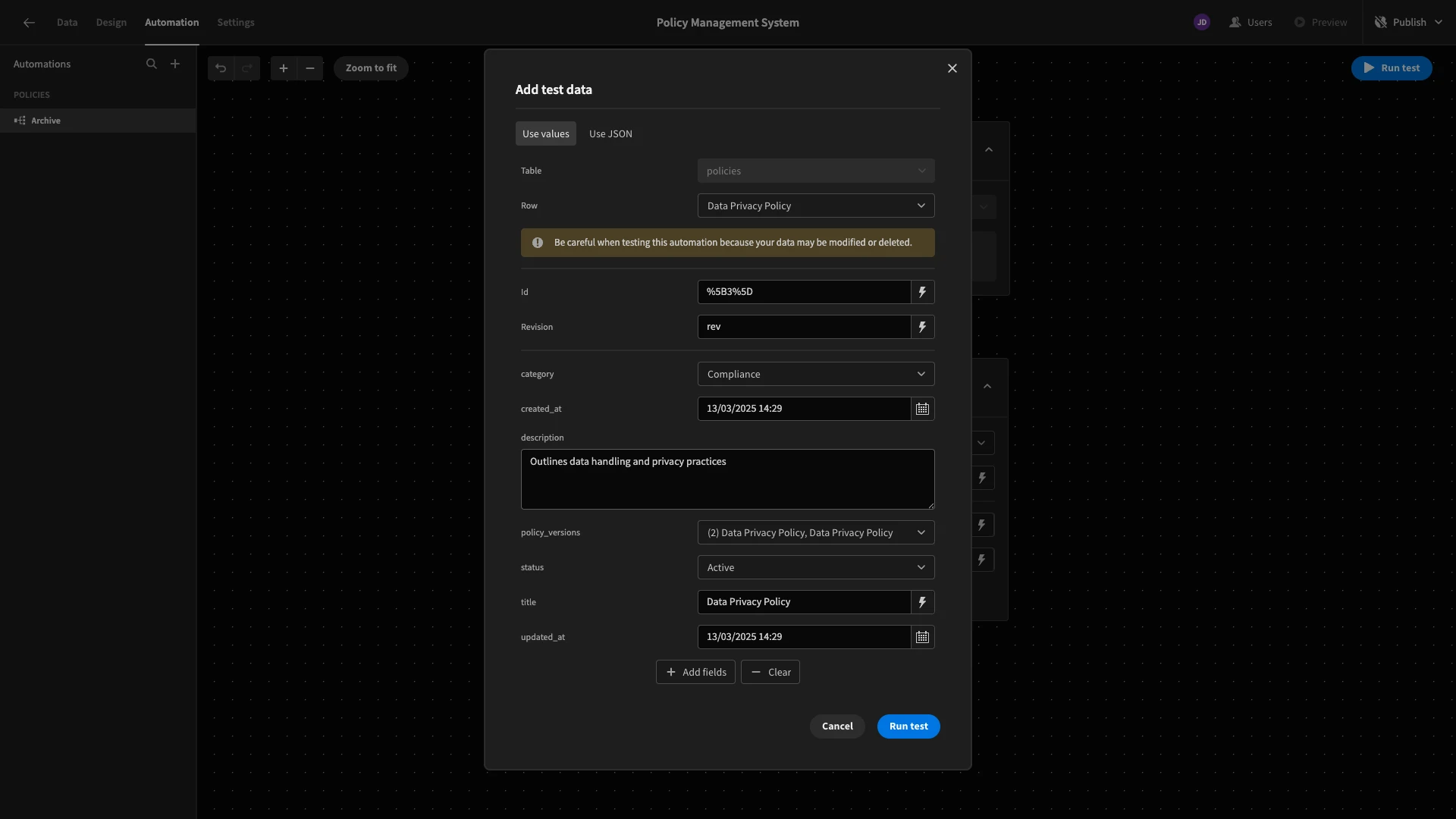
Approving policy change requests
Next, weÔÇÖre going to build an automation that will be triggered each time a policy_version is approved. This will take the data from the approved version and use it to update the corresponding row on the policies table.
WeÔÇÖll start by adding a new automation, which weÔÇÖll call Approve. This time, weÔÇÖre selecting a Row Updated trigger.
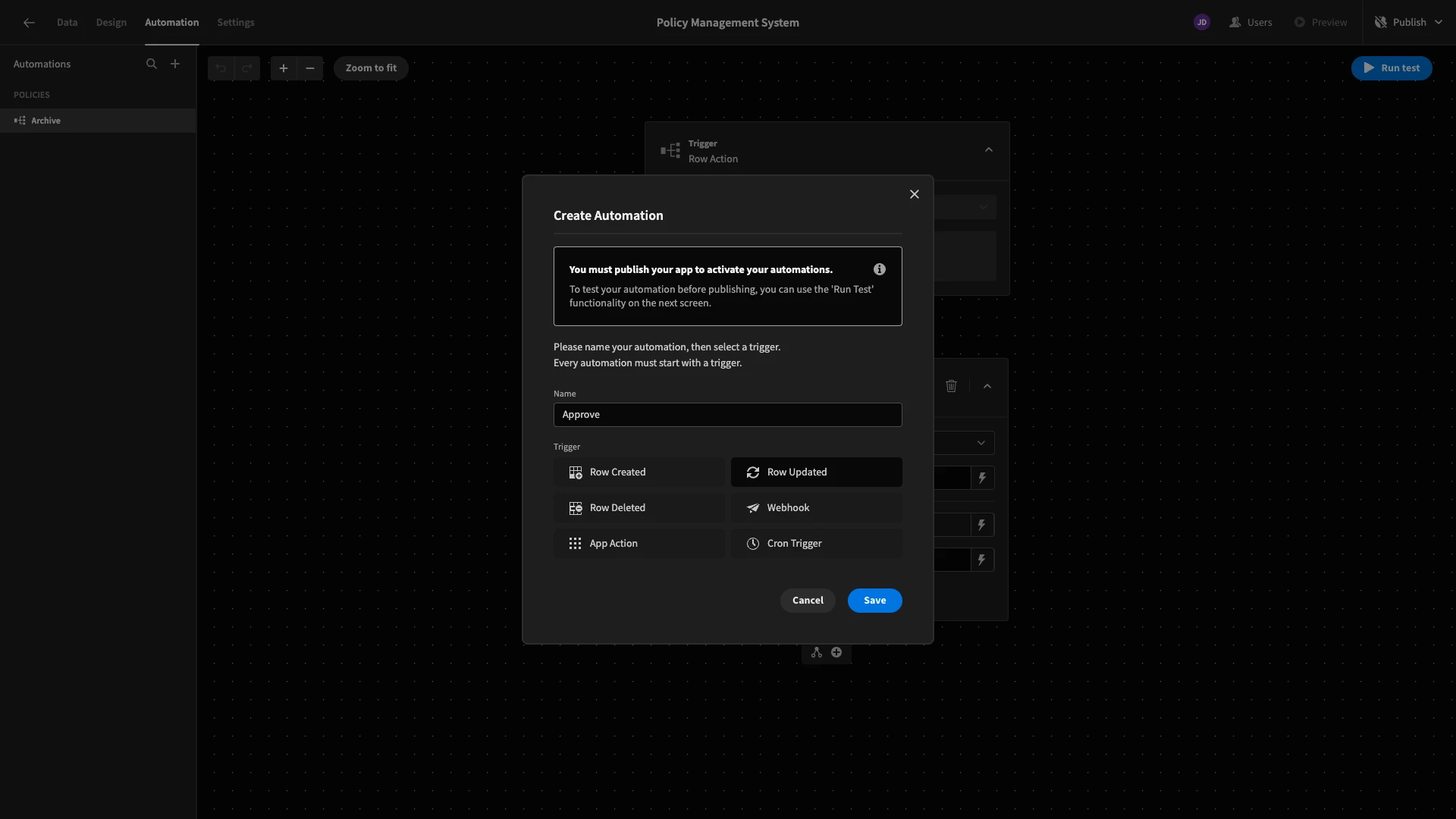
WeÔÇÖll set the Table for our trigger to policy_versions.

Next, weÔÇÖll add a condition so that we only continue if {{ trigger.row.status }} equals Approved.

Next, we need to retrieve the relevant policies row that our automation will update. To do this, weÔÇÖll add a Query Rows action, pointed at the policies table.

We only want to return the row thatÔÇÖs related to the policy_versions row thatÔÇÖs been approved. So, weÔÇÖll add a filter condition so that id equals {{ trigger.row.policy_id }}.

Lastly, weÔÇÖll use the id of the row this returns within an Update row action, pointed at the policies table.

WeÔÇÖll add category, title, updated_at, and description as fields and bind these to their respective values from our trigger output, along with the current timestamp for our updated_at field.
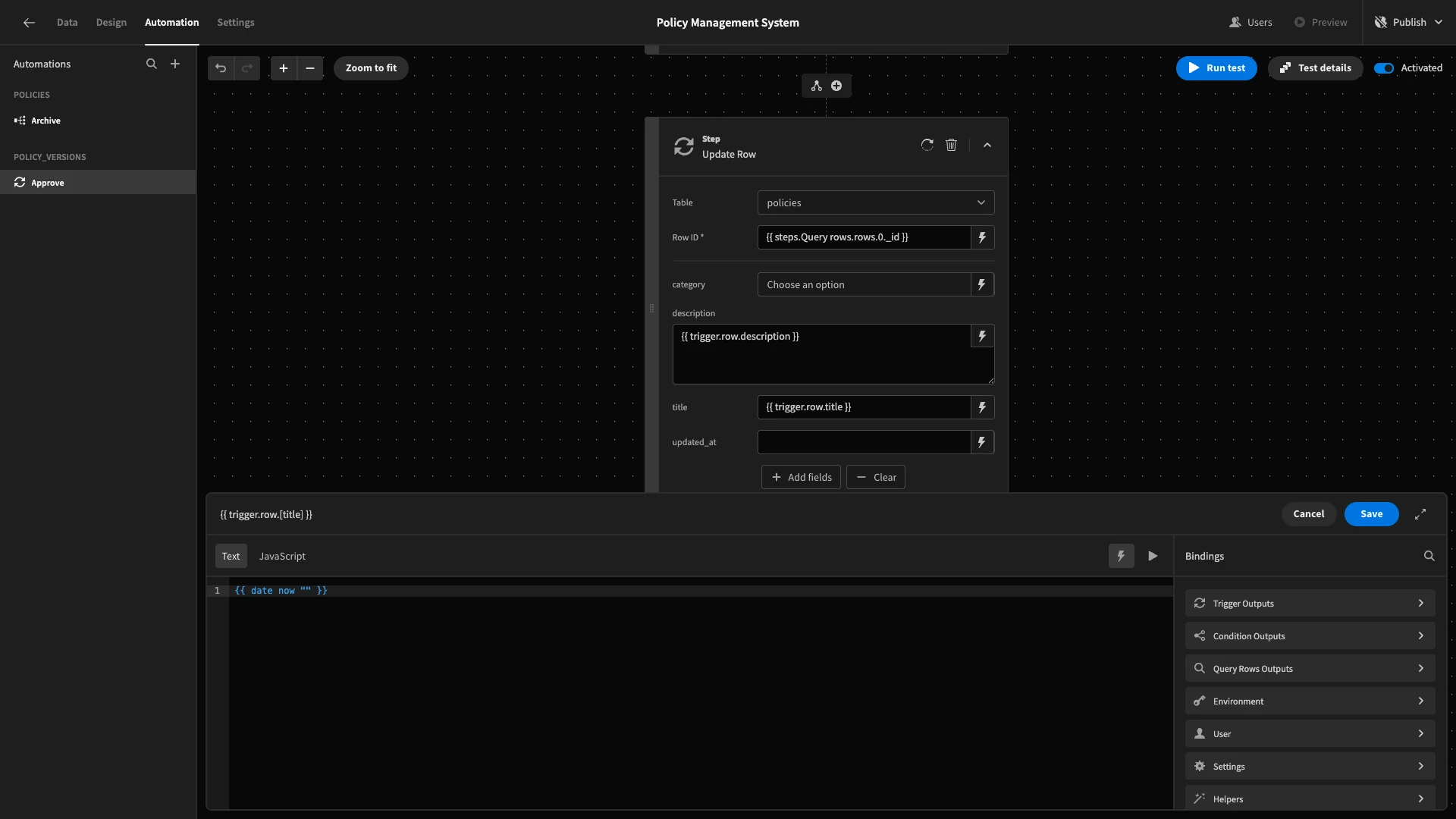
Again, weÔÇÖll hit Run Test to confirm that everything works.

3. Building a change request screen
Now that weÔÇÖve set up our automation logic, we can start building UIs. Head to the Editor Policies view in the data section and hit Generate App Screen.

Here, weÔÇÖll choose the option for a table with modal forms.

HereÔÇÖs how this will look in the Design section.
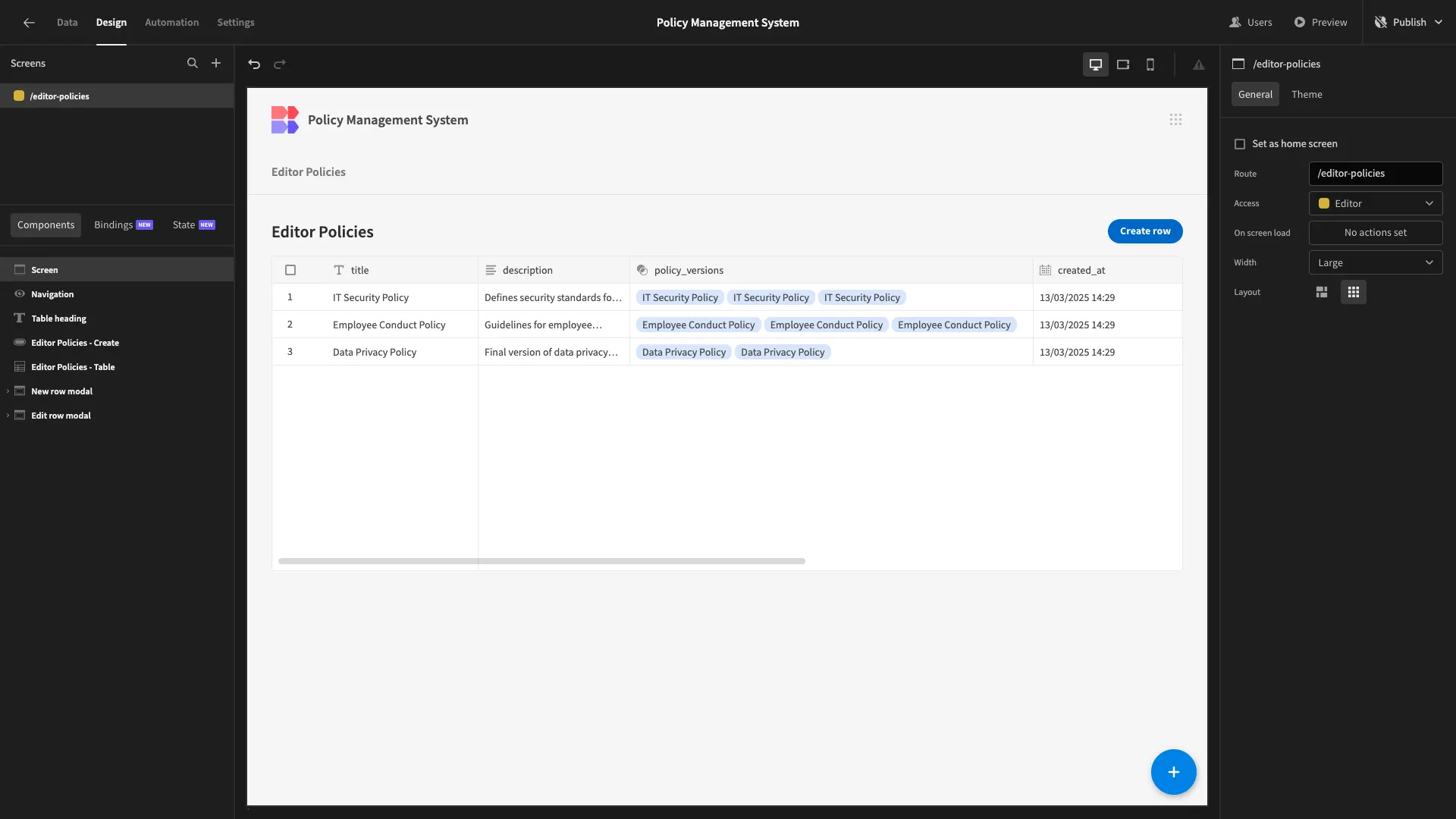
The first thing weÔÇÖll do is tidy up our existing UI by editing our Headline component and removing any unnecessary columns from our table.
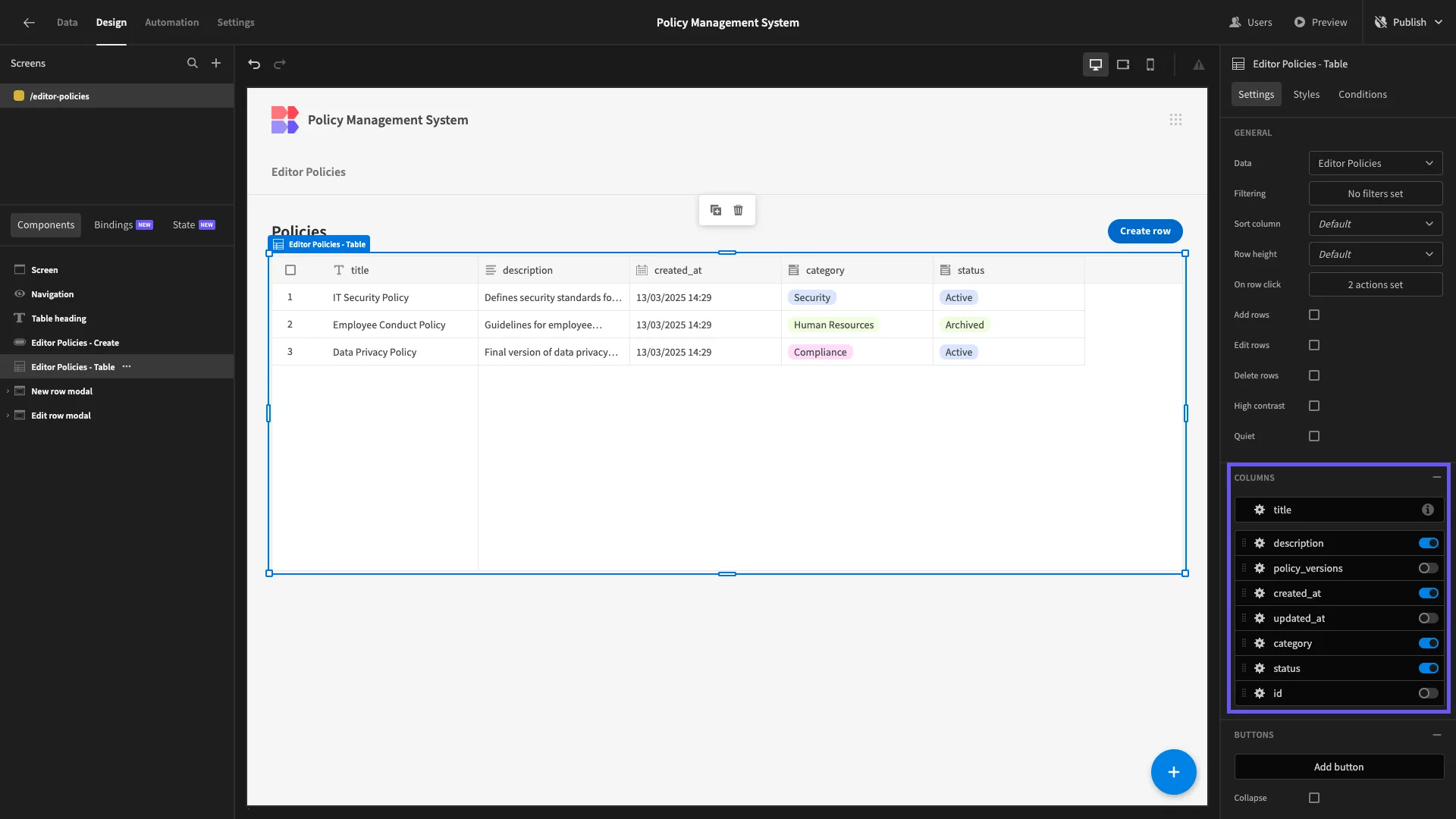
Editors arenÔÇÖt allowed to add new rows to the policies table, so we can also delete our Create New button and the associated modal form.

HereÔÇÖs our remaining Edit form.

At present, this updates the policies row that a user clicks on in our table. WeÔÇÖre going to modify this so that it creates a new policy_versions row, linked to the policies row that a user clicks on.
WeÔÇÖll start by setting our formÔÇÖs Data to Editor Versions and its Type to Create.
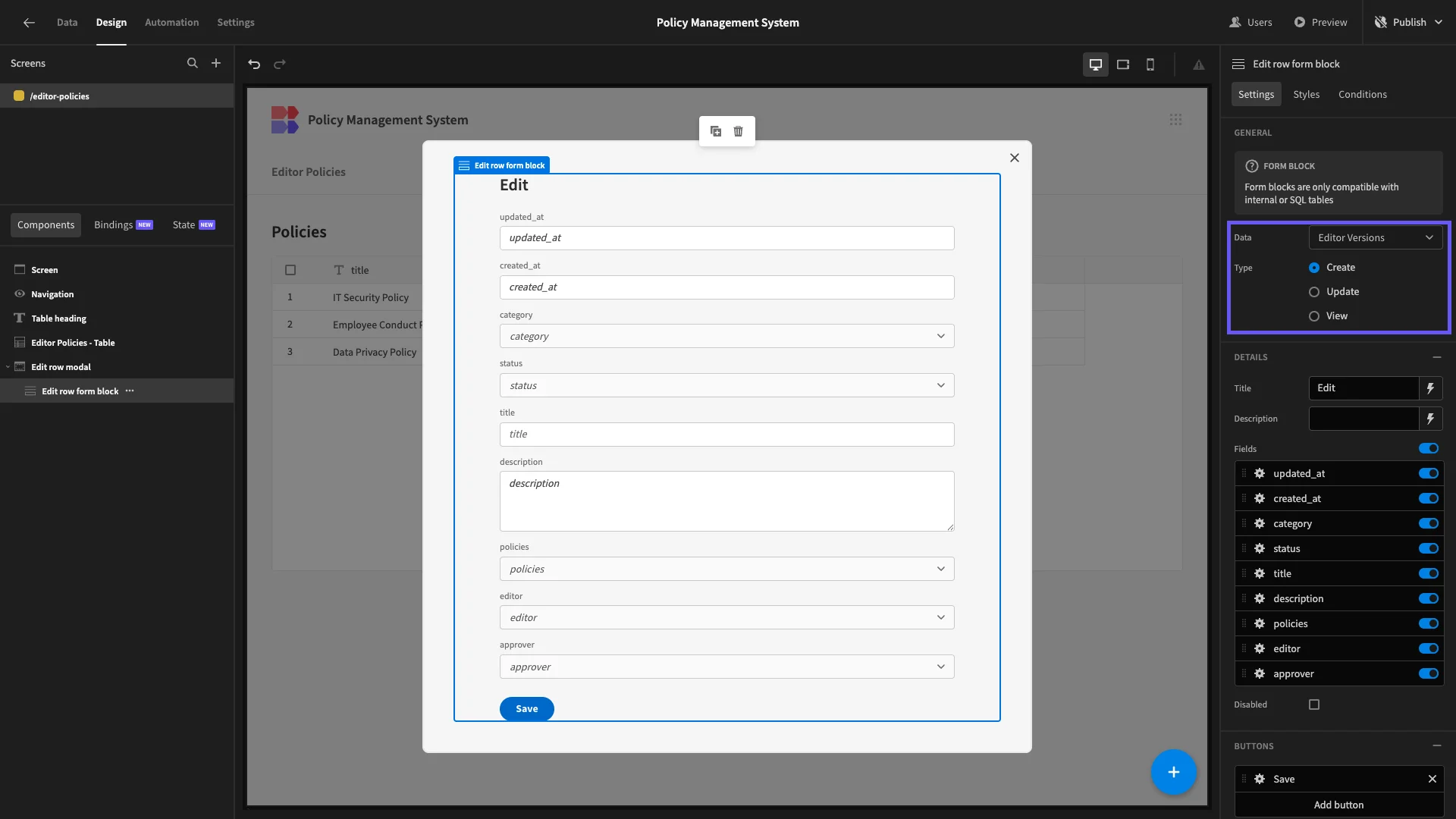
WeÔÇÖll then remove all fields except policies, title, category, and description.
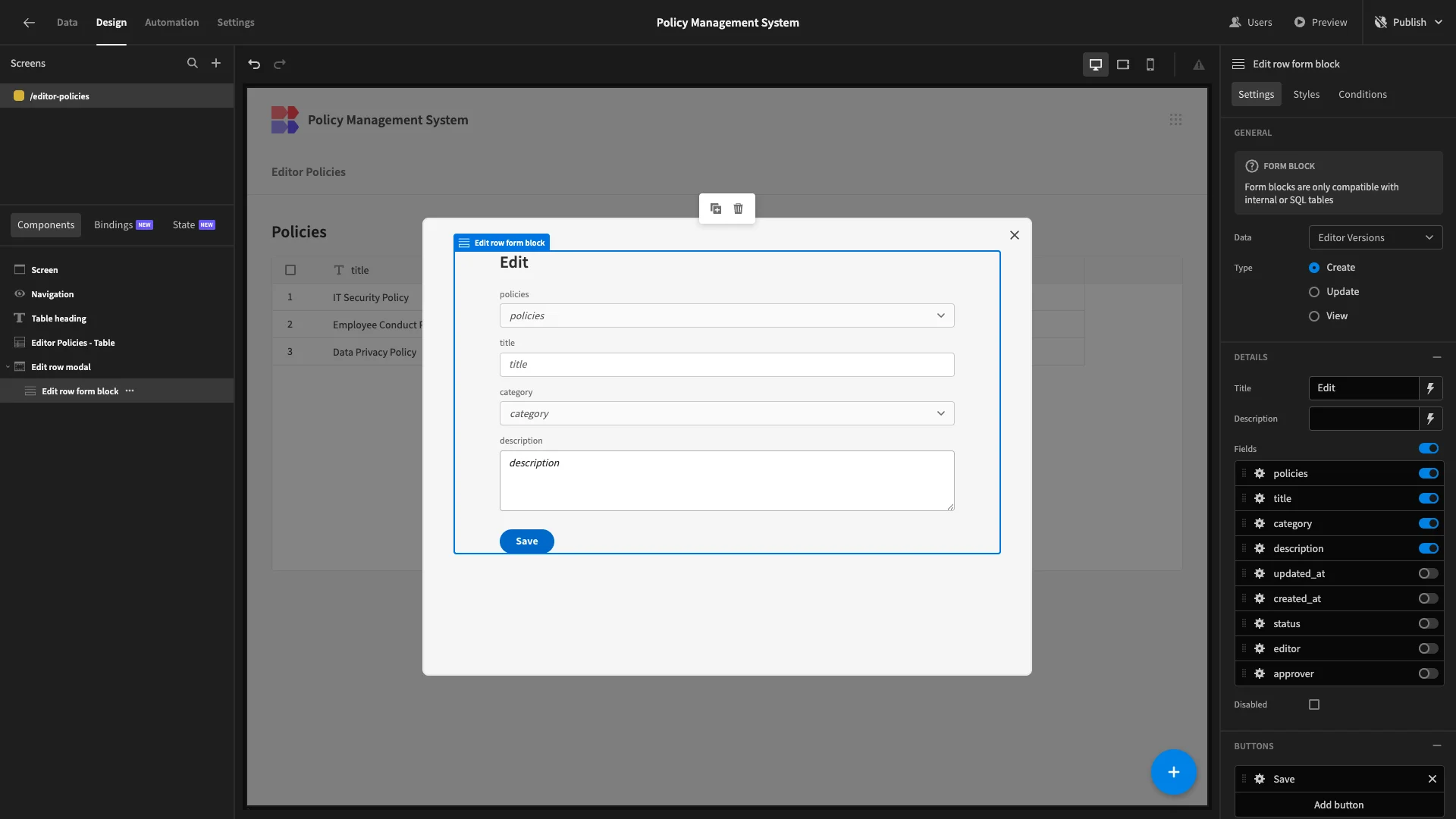
WeÔÇÖll also update our display text, then under Styles, set our Button Position to Top.
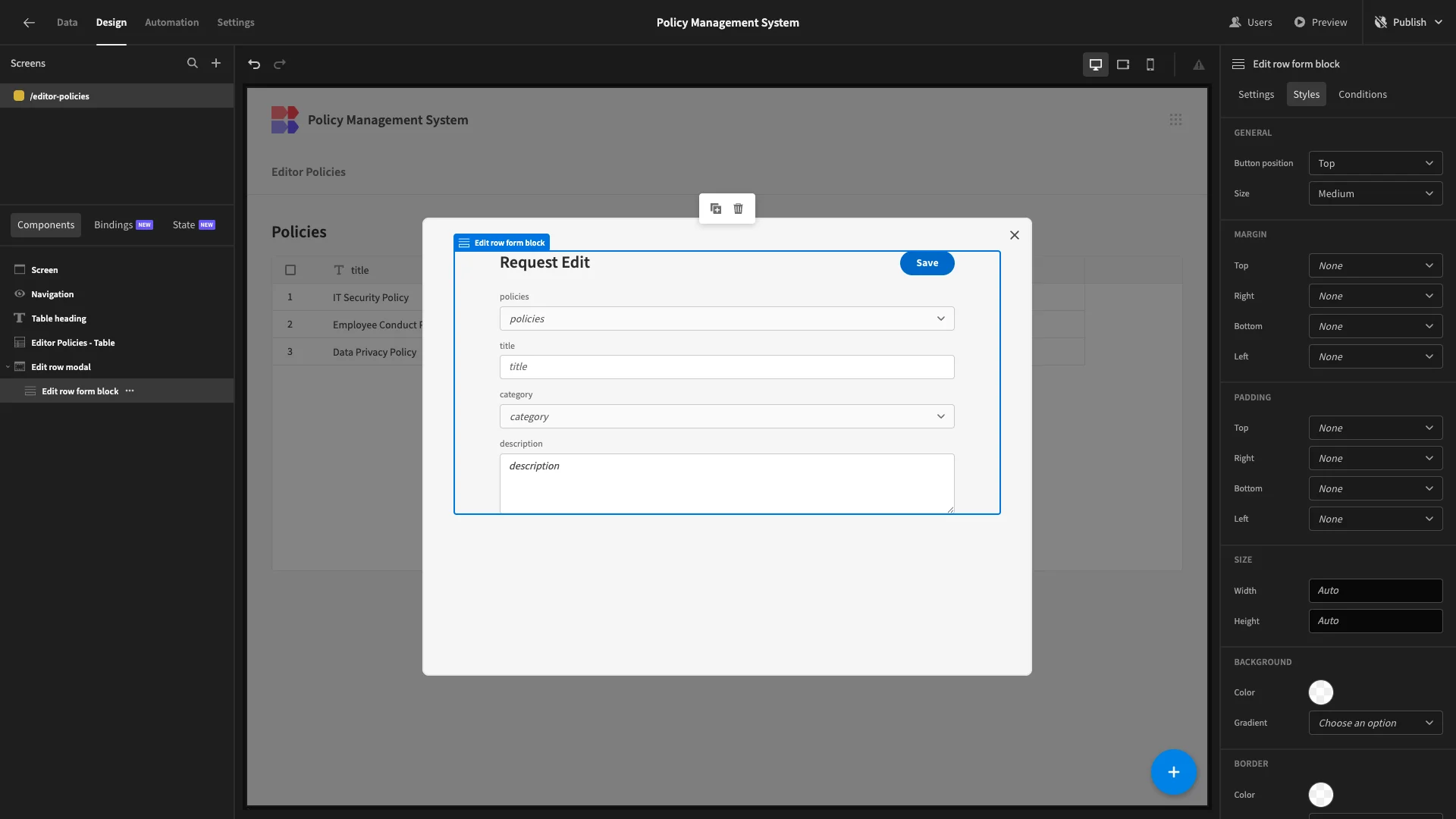
Now, we donÔÇÖt want users to have to specify the policy theyÔÇÖre editing. Rather, this should be automatically populated based on which table row they click.
Currently, when a user clicks on a row, a State variable is set, using the clicked rowÔÇÖs _id. WeÔÇÖre going to set a default value for our policy field using this, with {{ State.ID_5Whzvriuv }}. WeÔÇÖll then select the option to disable this field, so it canÔÇÖt be written.
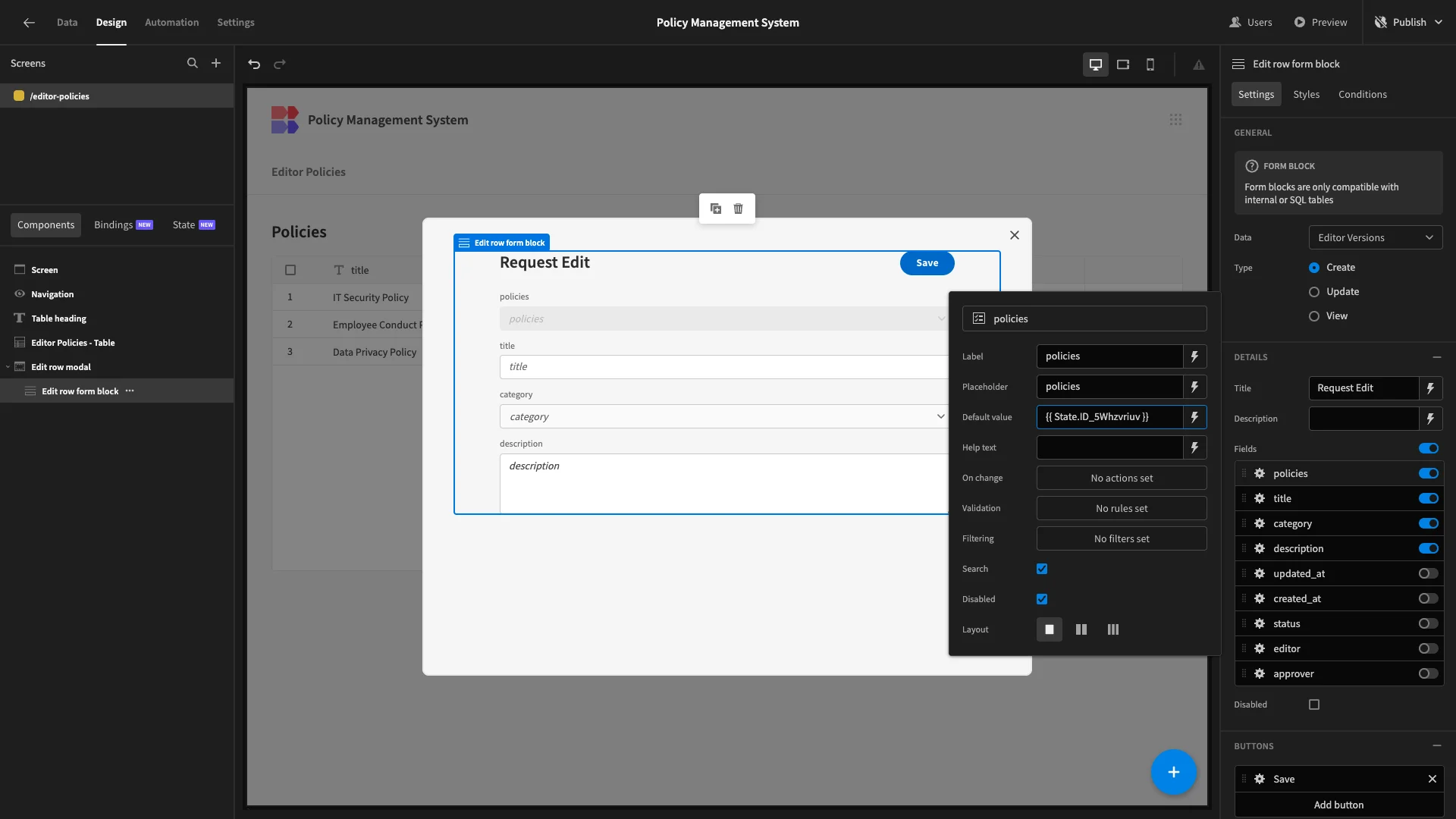
HereÔÇÖs how this will look when we preview our app.
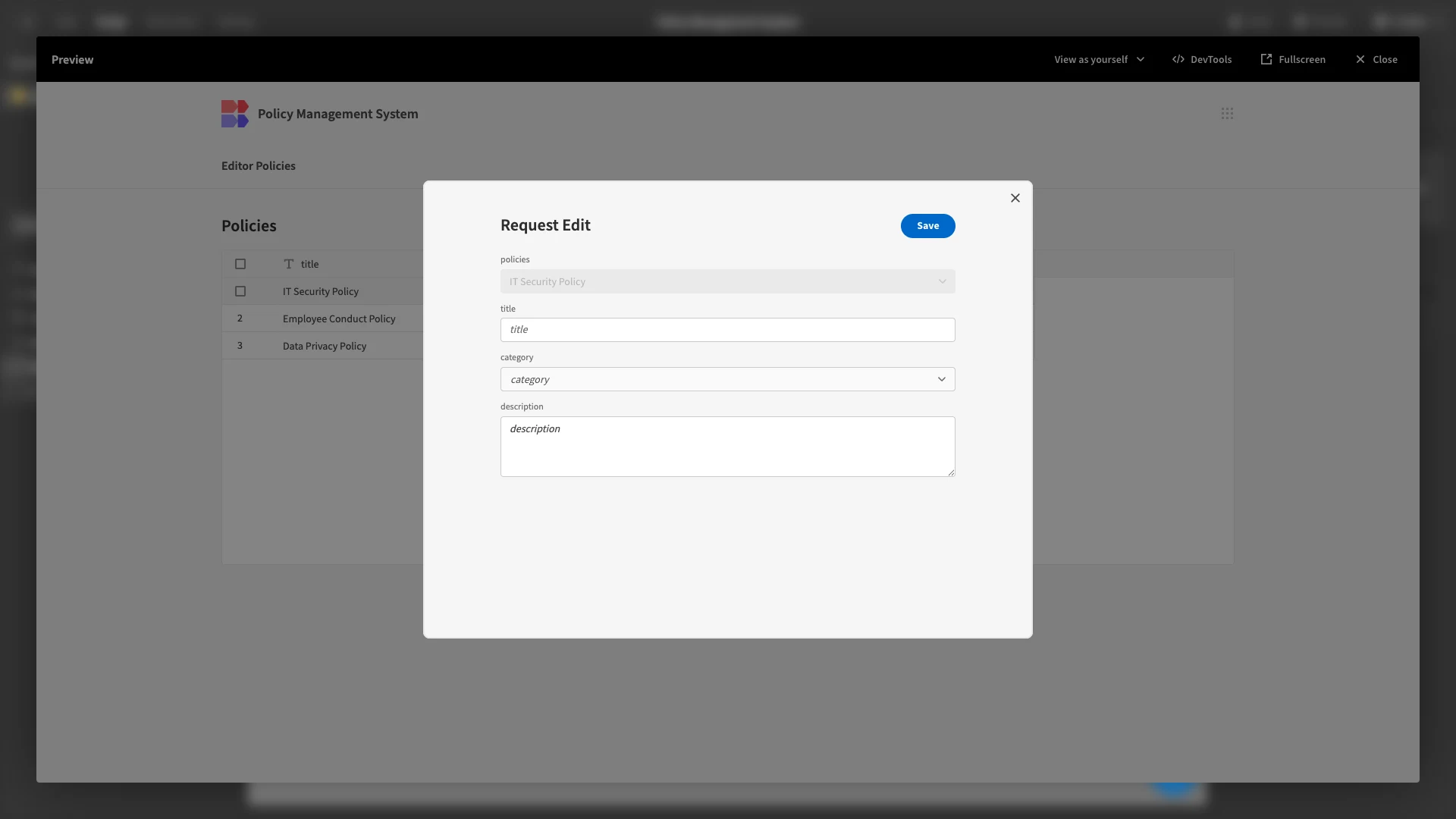
However, we also want to display the current values of our policy data, so that users donÔÇÖt need to rewrite this from scratch. To do this, weÔÇÖll need to expose our form to the entire policies row to which our new version will be related.
WeÔÇÖll start by nesting our Form Block inside a Data Provider component.
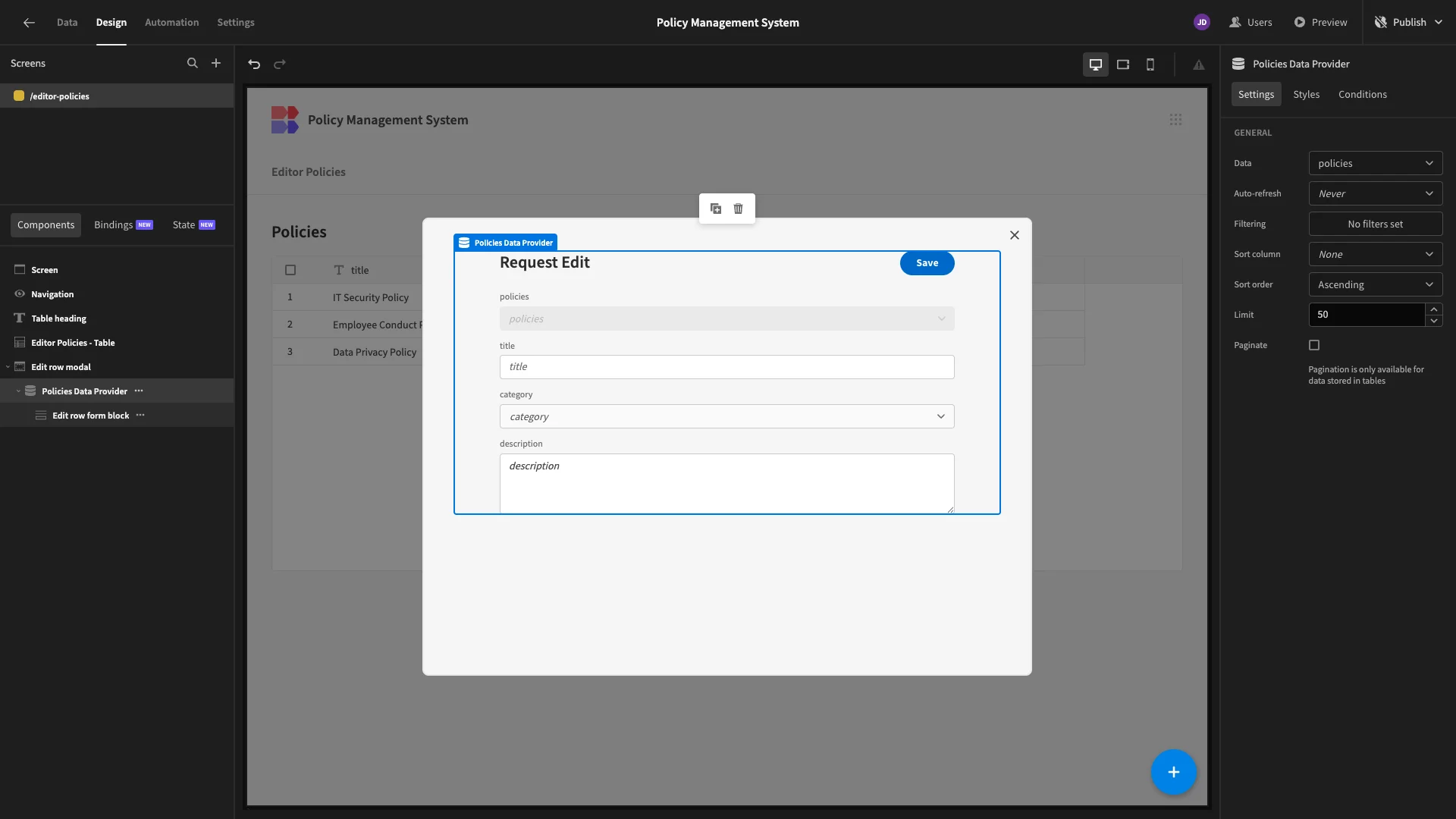
Then, weÔÇÖll add a filter to this so that it only returns the single row where _id equals our state variable from before.
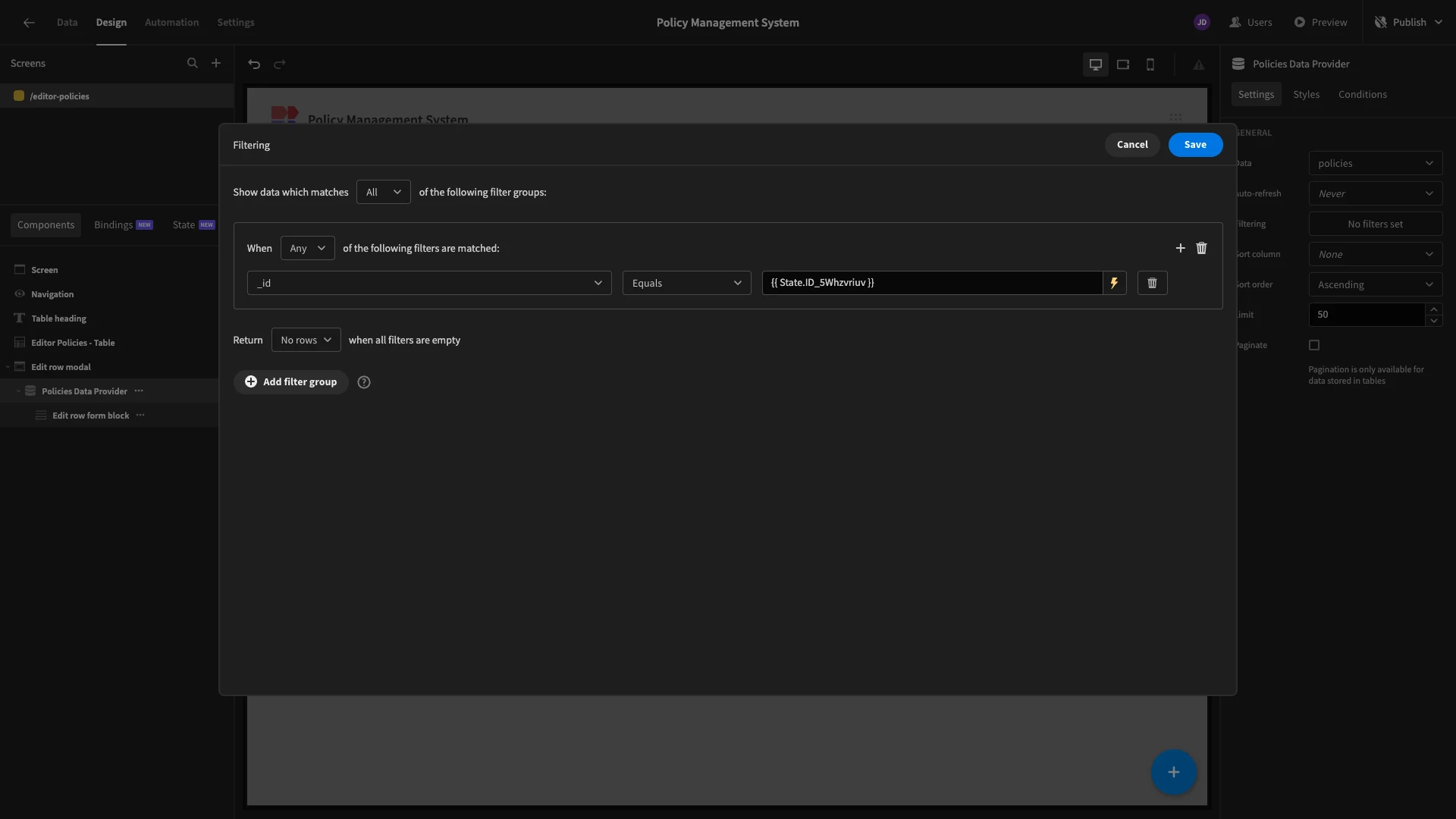
WeÔÇÖll then add default values to our remaining fields in the format {{ [Policies Data Provider].Rows.0.category }}.

HereÔÇÖs how this looks in our preview.

4. Building approver screens
Next, weÔÇÖll start building screens for our Approvers.
Policy CRUD UIs
Firstly, we want to build a screen where users with the Approval role will have full CRUD permissions for our policies table.
WeÔÇÖll start by generating another table UI with modal forms, this time from our Approver Policies view.
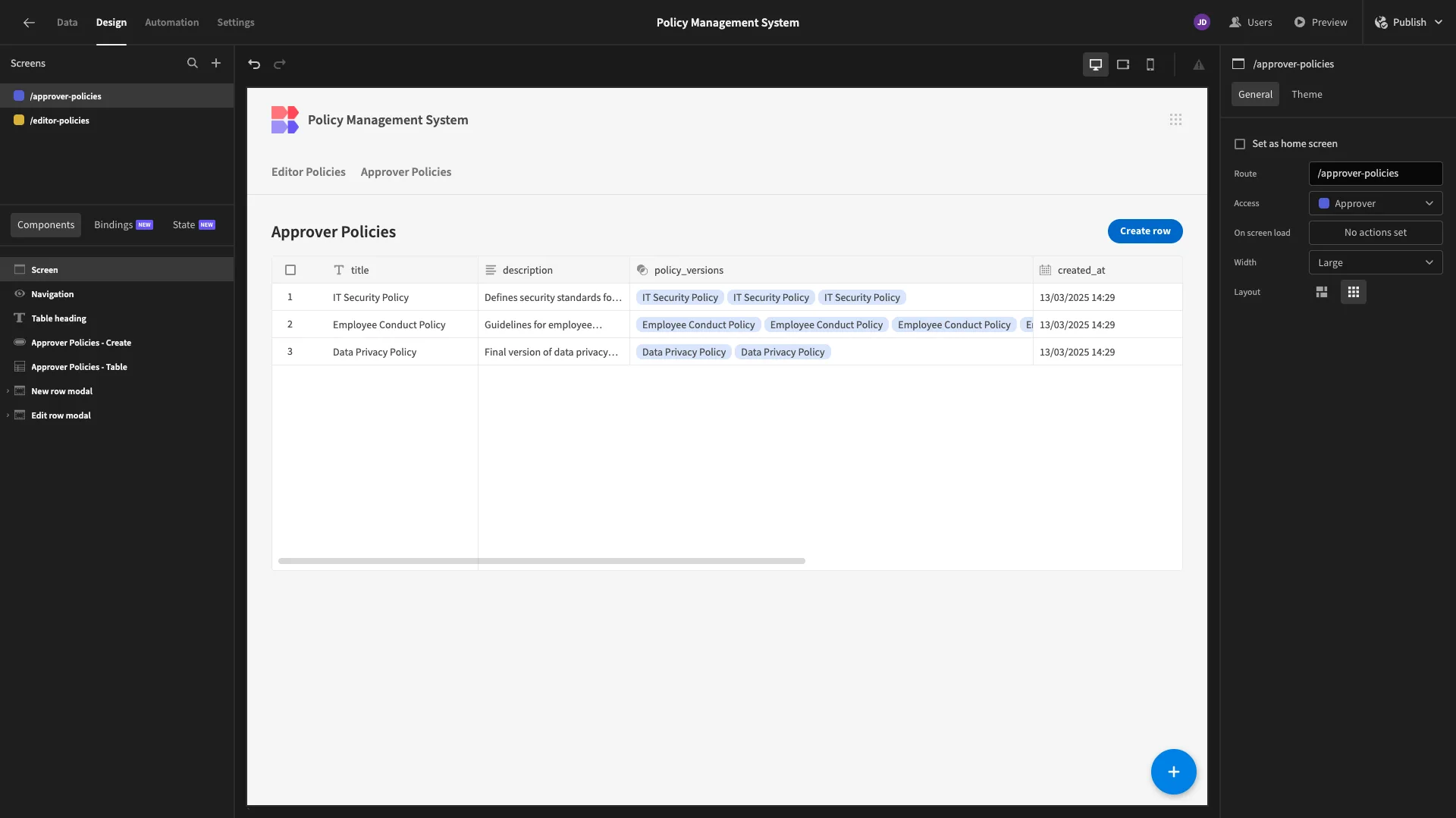
As before, weÔÇÖll start by editing our display text and removing any extraneous columns from our table.

For our Create form, weÔÇÖre removing all columns except title, description, and category. WeÔÇÖve also moved our button to the top again.

On our Edit form, weÔÇÖre leaving all columns visible, but setting the ones we donÔÇÖt need to Disabled, weÔÇÖve also arranged them into columns using their Layout settings.

Note that when we generated this screen, it automatically included a button to trigger our Archive row action. Since we have this, we donÔÇÖt need our Delete button, so weÔÇÖll remove that.
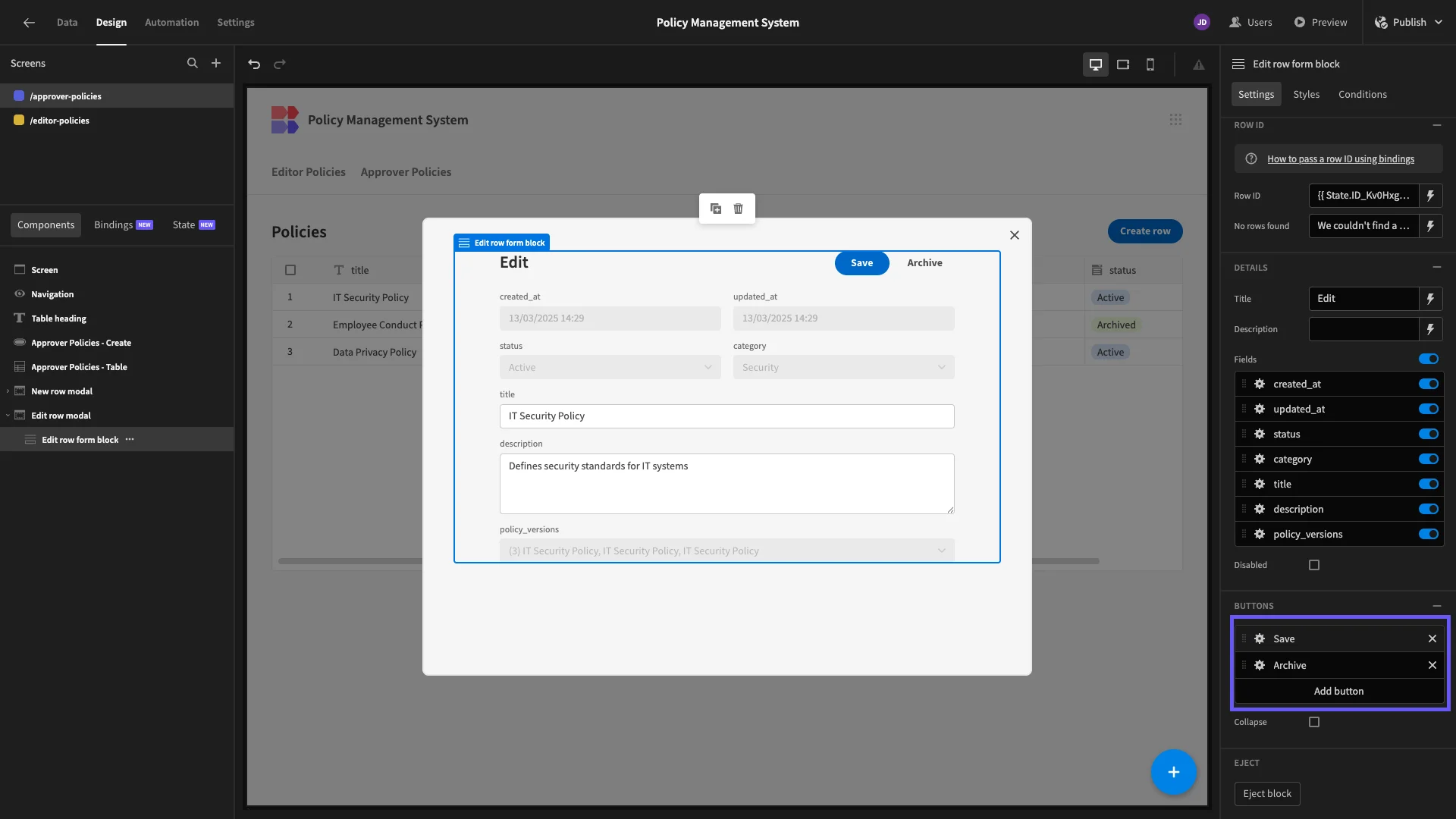
Lastly, we need to set our updated_at column to the current timestamp whenever a user updates a row. To do this, weÔÇÖll open the actions drawer for our Save button.
Here, we can manually specify a value for our column, using {{ date now ÔÇ£ÔÇØ }}.
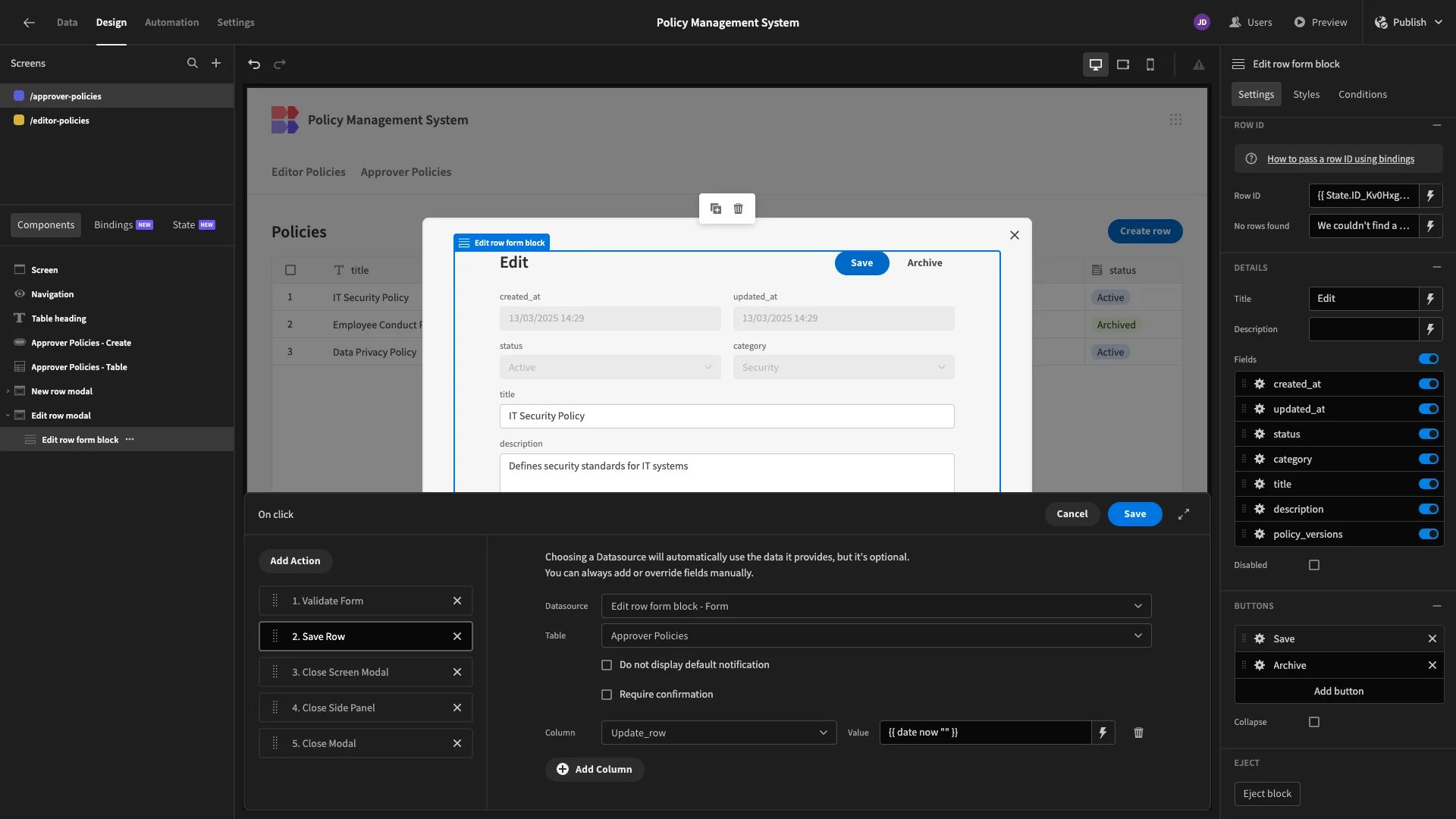
Policy version approvals
Next, weÔÇÖre going to add a screen where users can review and approve new policy_versions.
So, weÔÇÖll start by generating a screen from our Approver Versions view.
Again, weÔÇÖve updated our display text and removed any columns we donÔÇÖt need.
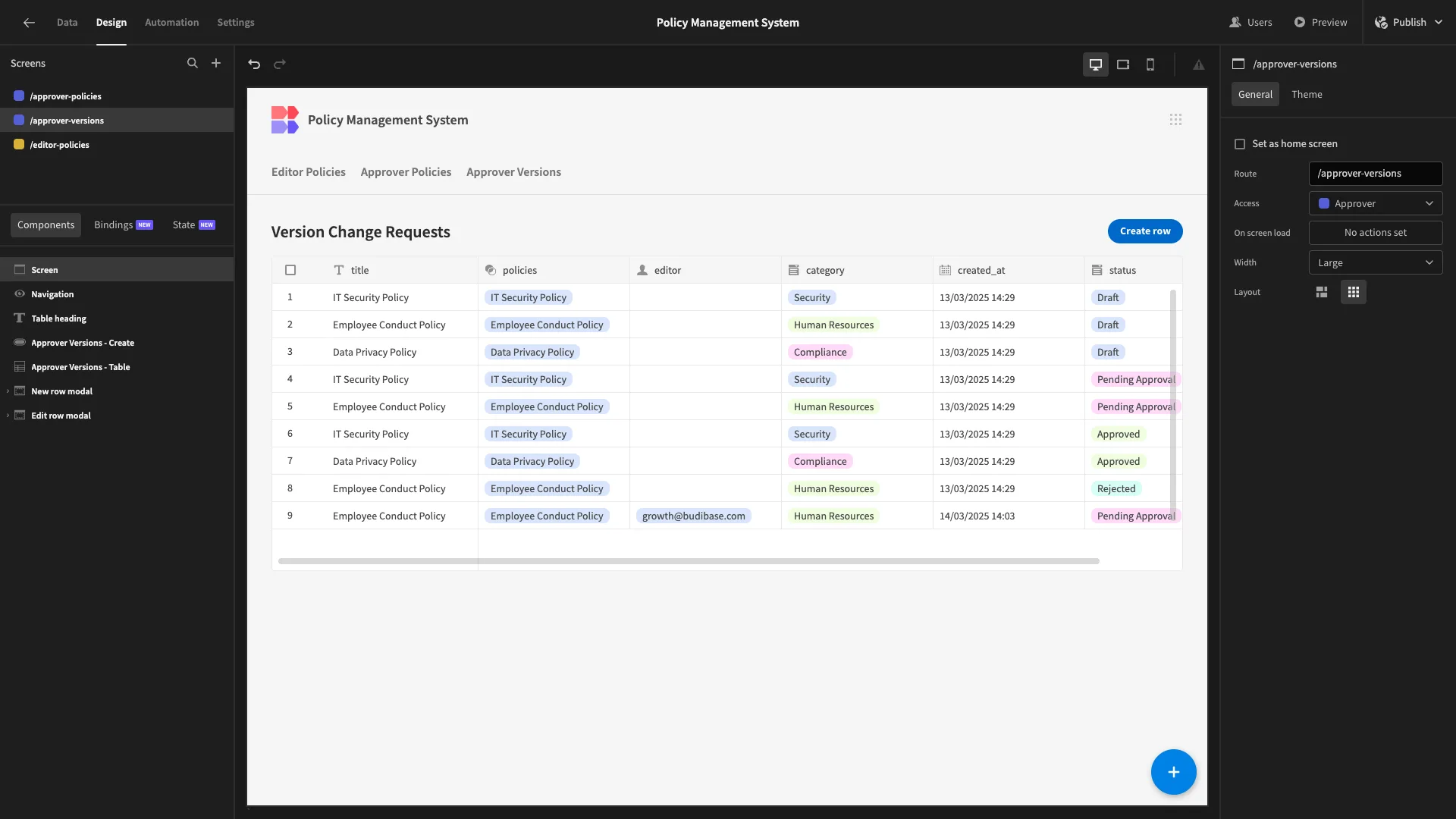
Approvers donÔÇÖt need to create new policy_versions, so weÔÇÖll delete the button and modal forms that relate to this. WeÔÇÖve then replaced our button with an Options Picker with its field and placeholder set to Status.
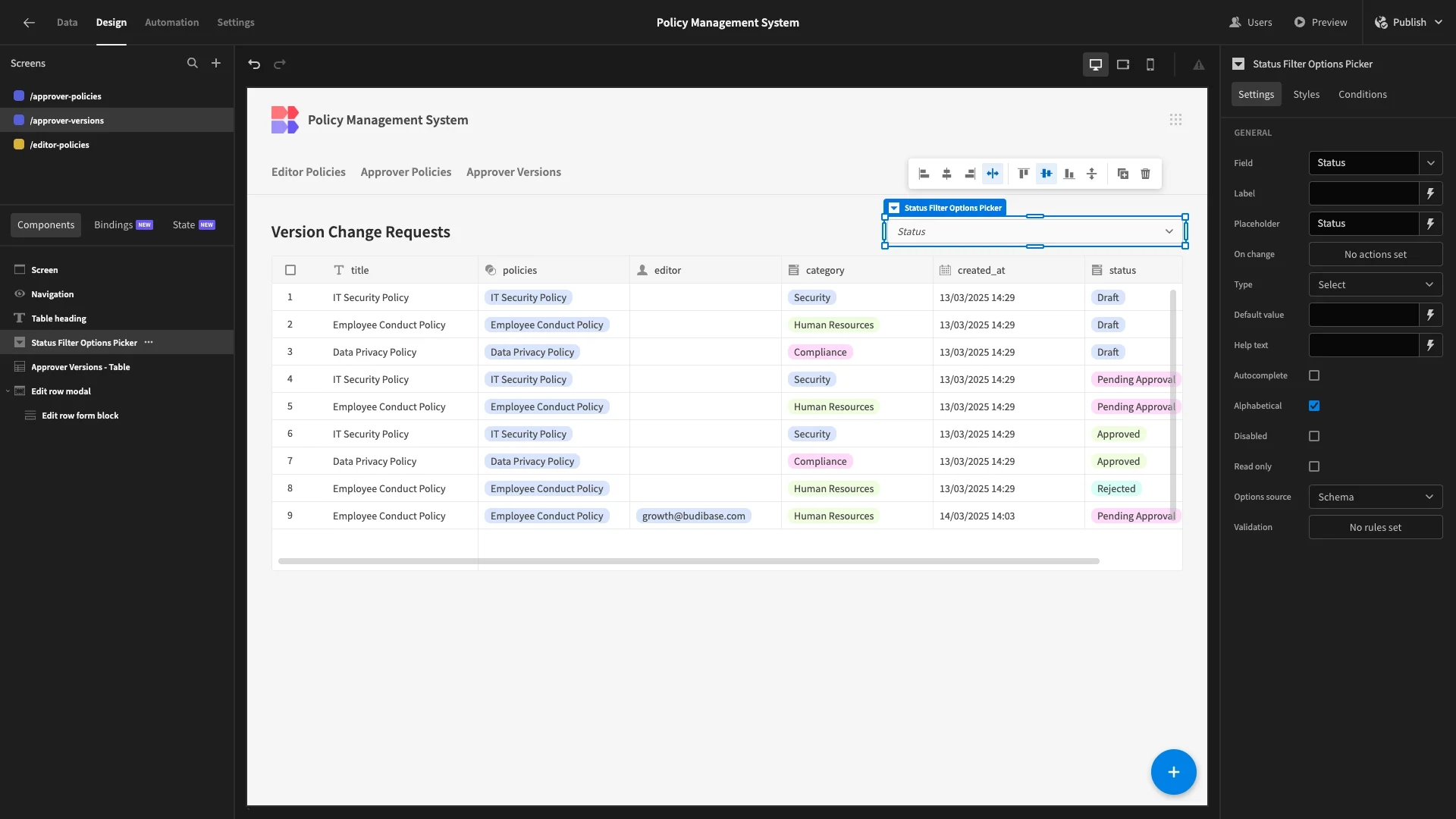
WeÔÇÖll set the options for this to match the possible status values from our database, as well as giving it a default value of Pending Approval.

Then, weÔÇÖll add a filter to our table so that it only returns rows where status equals {{ [Status Filter Options Picker].Value }}
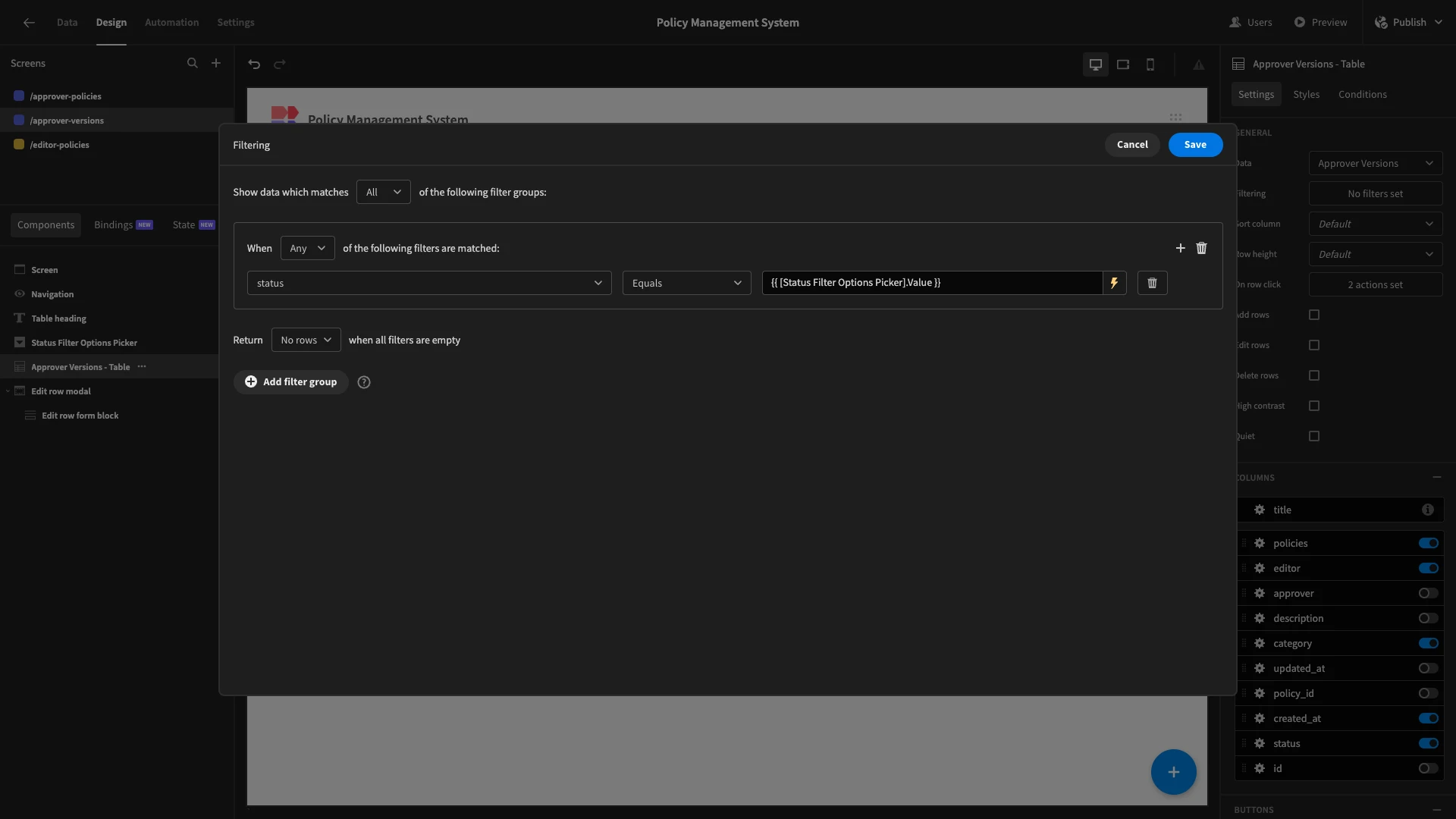
Now, when we load the screen, only pending requests appear by default.
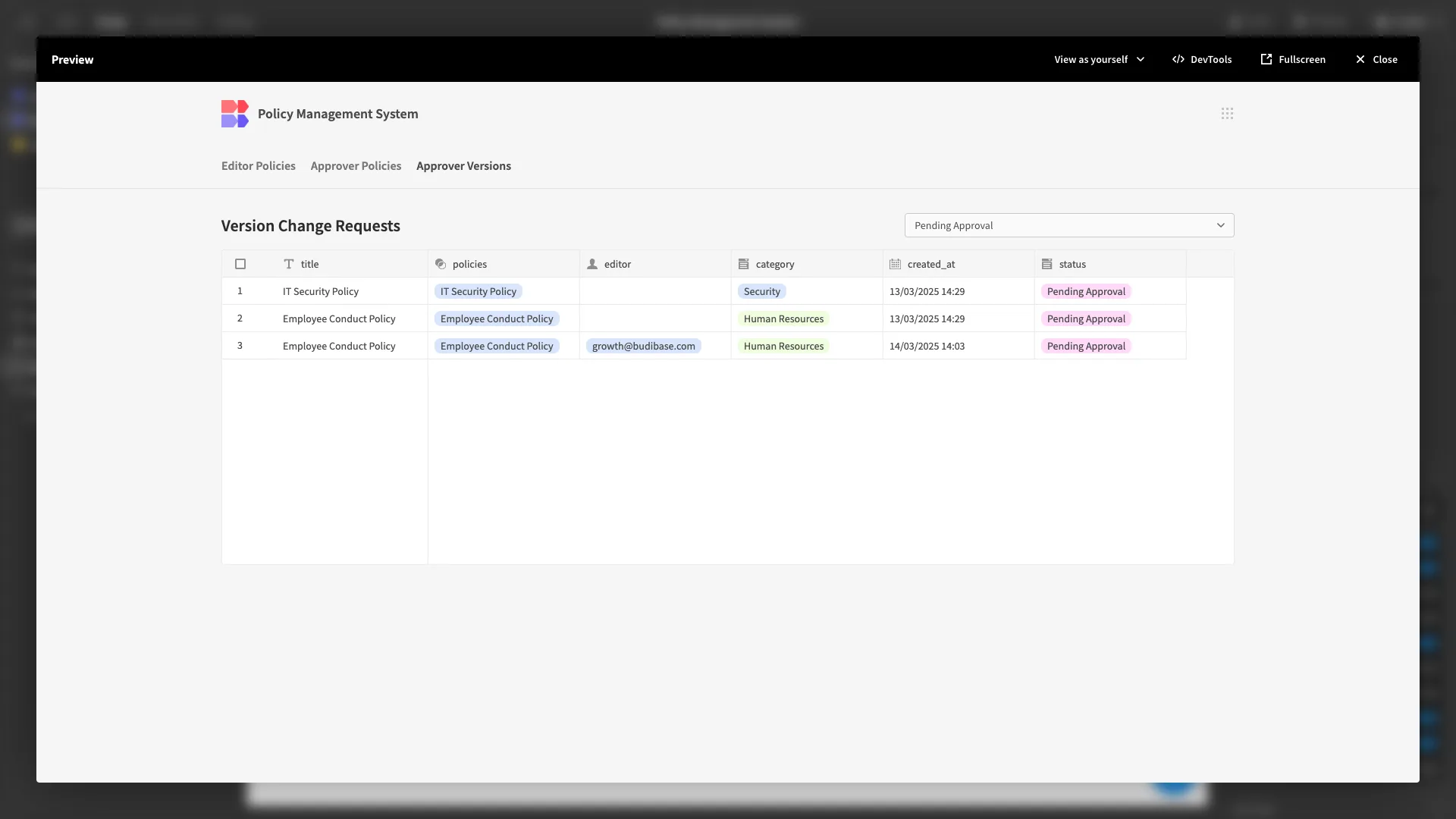
Lastly, on our remaining form, weÔÇÖve set all fields to disabled except for status.

Then, under our save buttonÔÇÖs actions, weÔÇÖll use the same binding as before to populate an updated_at value, as well as setting our approver column to {{ Current User._id }}.

From a functional point of view, thatÔÇÖs our app done.
5. Design tweaks and publishing
Before we push our policy management system live, weÔÇÖre going to make a few minor UX improvements.
Firstly, under Screen and Theme, weÔÇÖll choose Midnight. While weÔÇÖre here, weÔÇÖll also adjust our appÔÇÖs color scheme to better reflect the ║┌┴¤ı²─▄┴┐ brand.
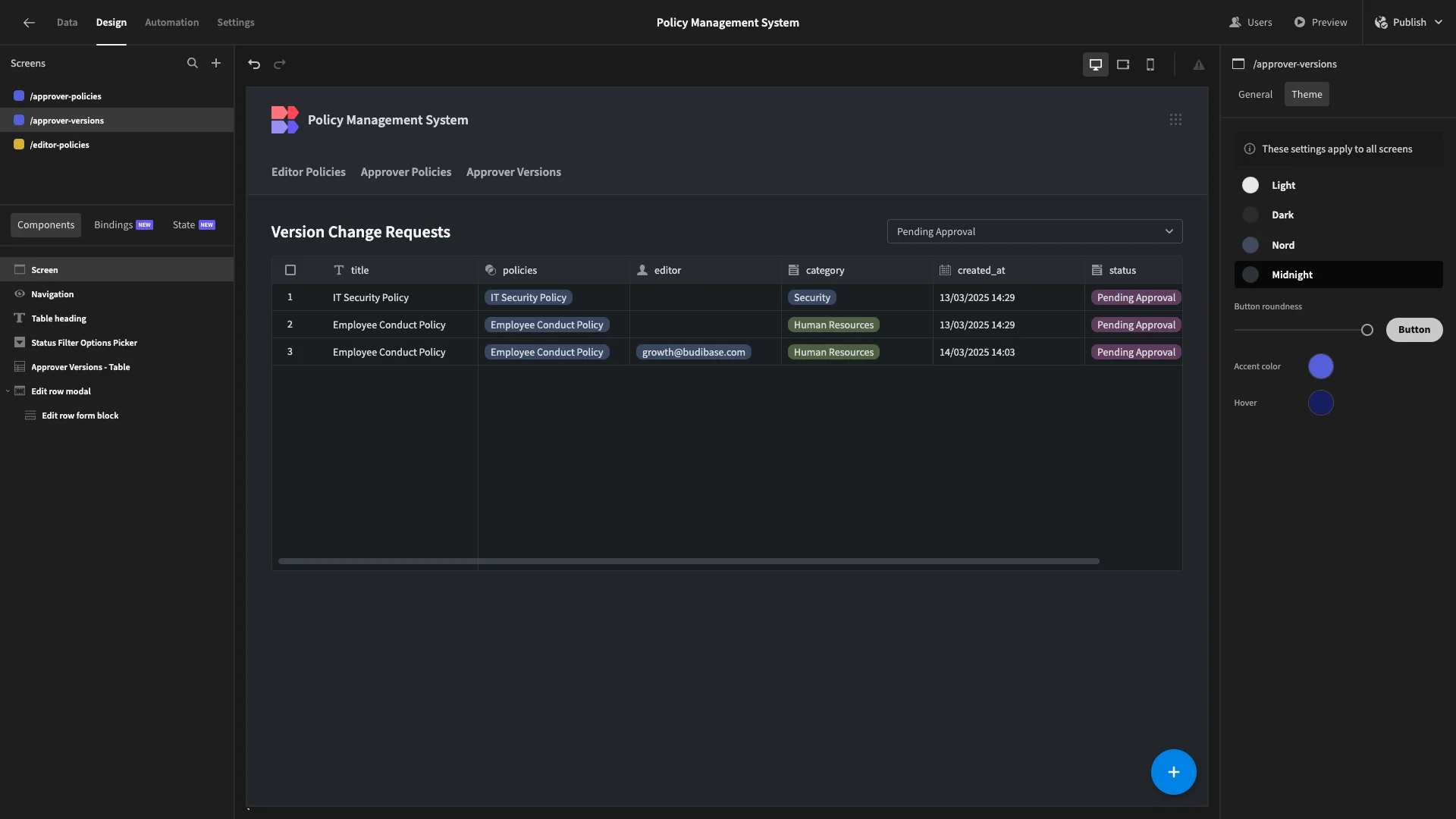
Across each of our tables, weÔÇÖll use the Label setting to add proper capitalization to our display texts.
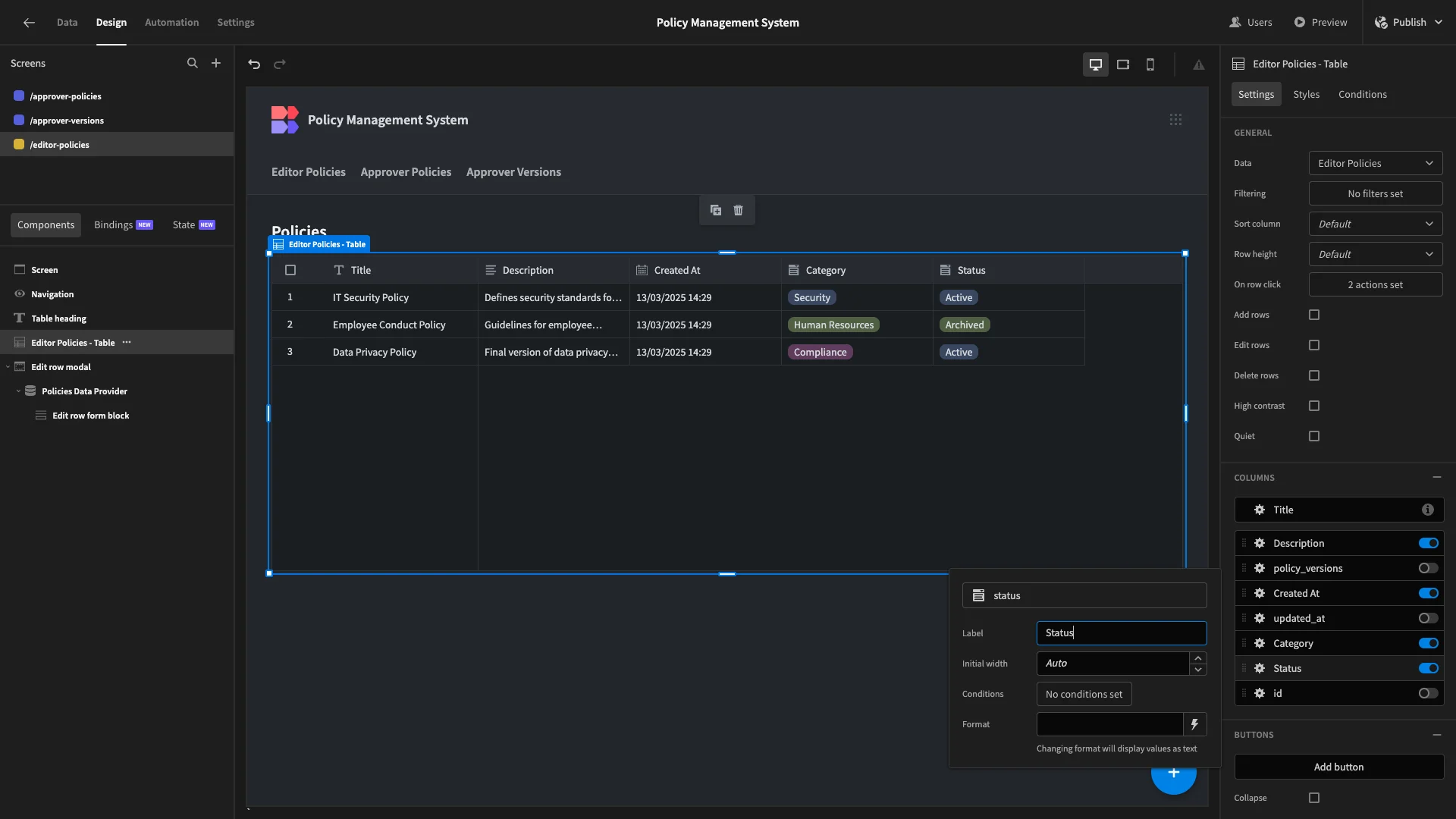
WeÔÇÖll do the same on our forms using the Label and Placeholder settings.
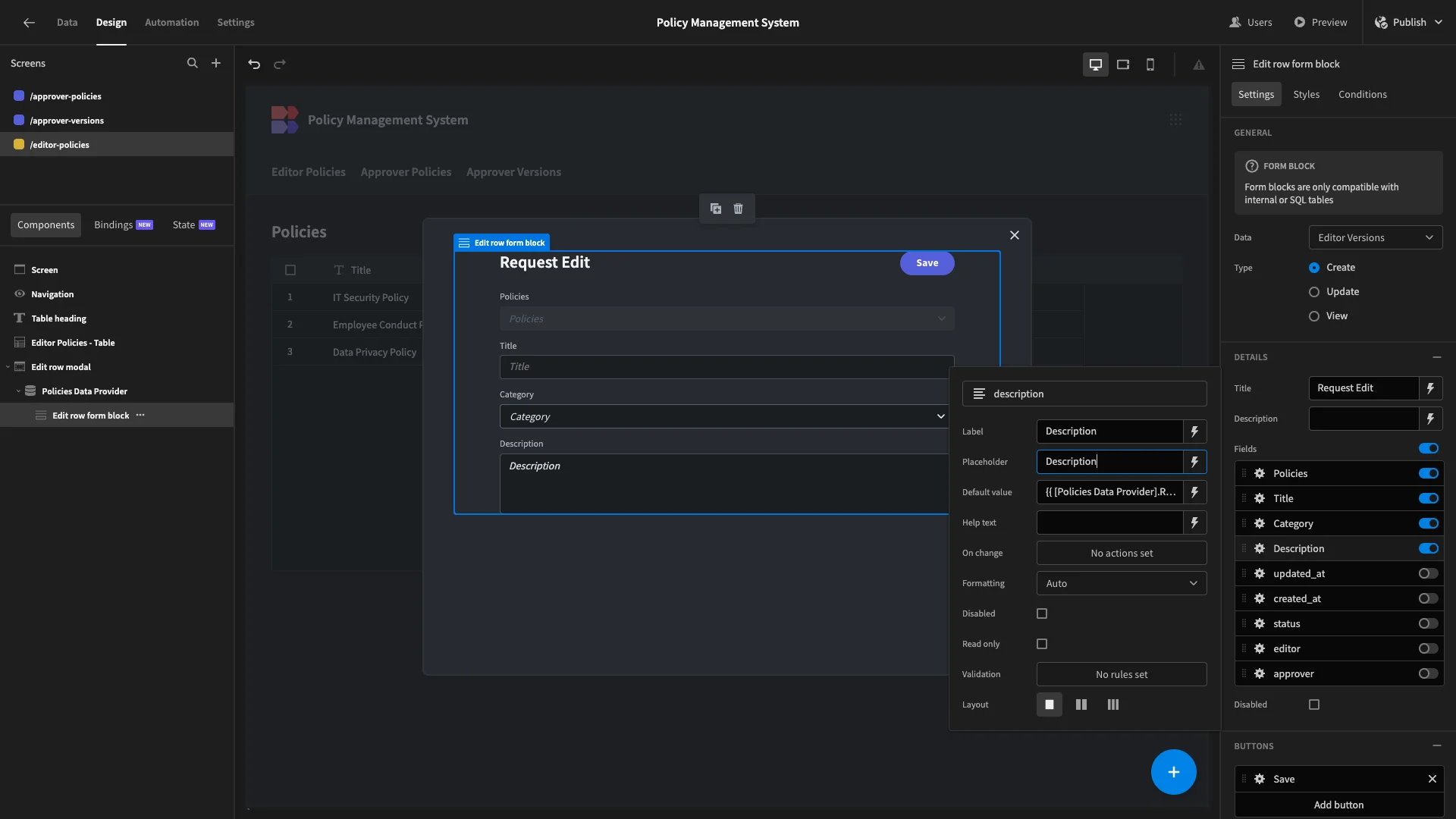
Similarly, weÔÇÖll use the Label settings under Navigation to make the entries in our nav bar more appropriate.
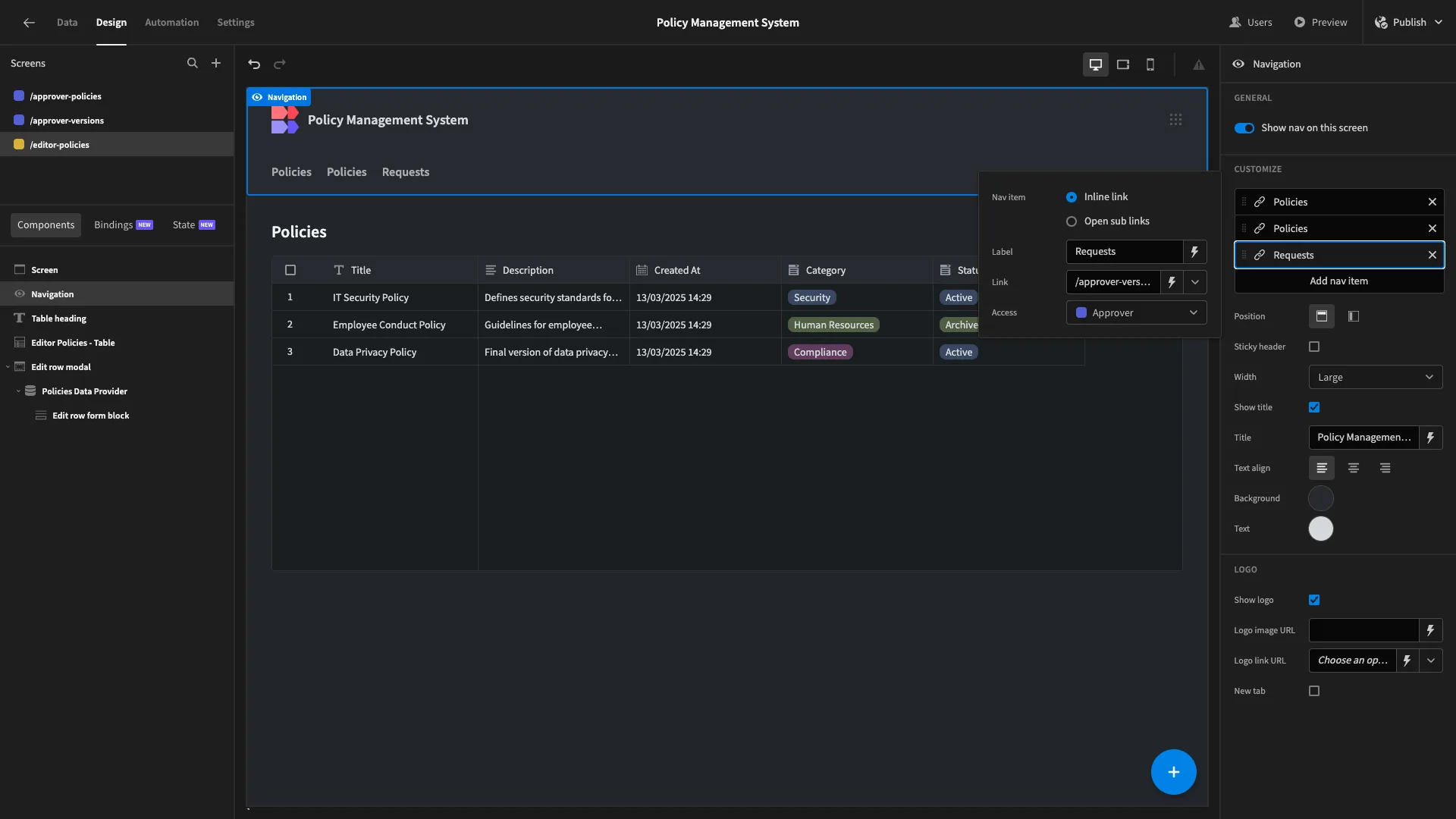
Lastly, weÔÇÖll remove the navigation entry for our /editor-policies screen since users with the Editor role can only access a single UI.
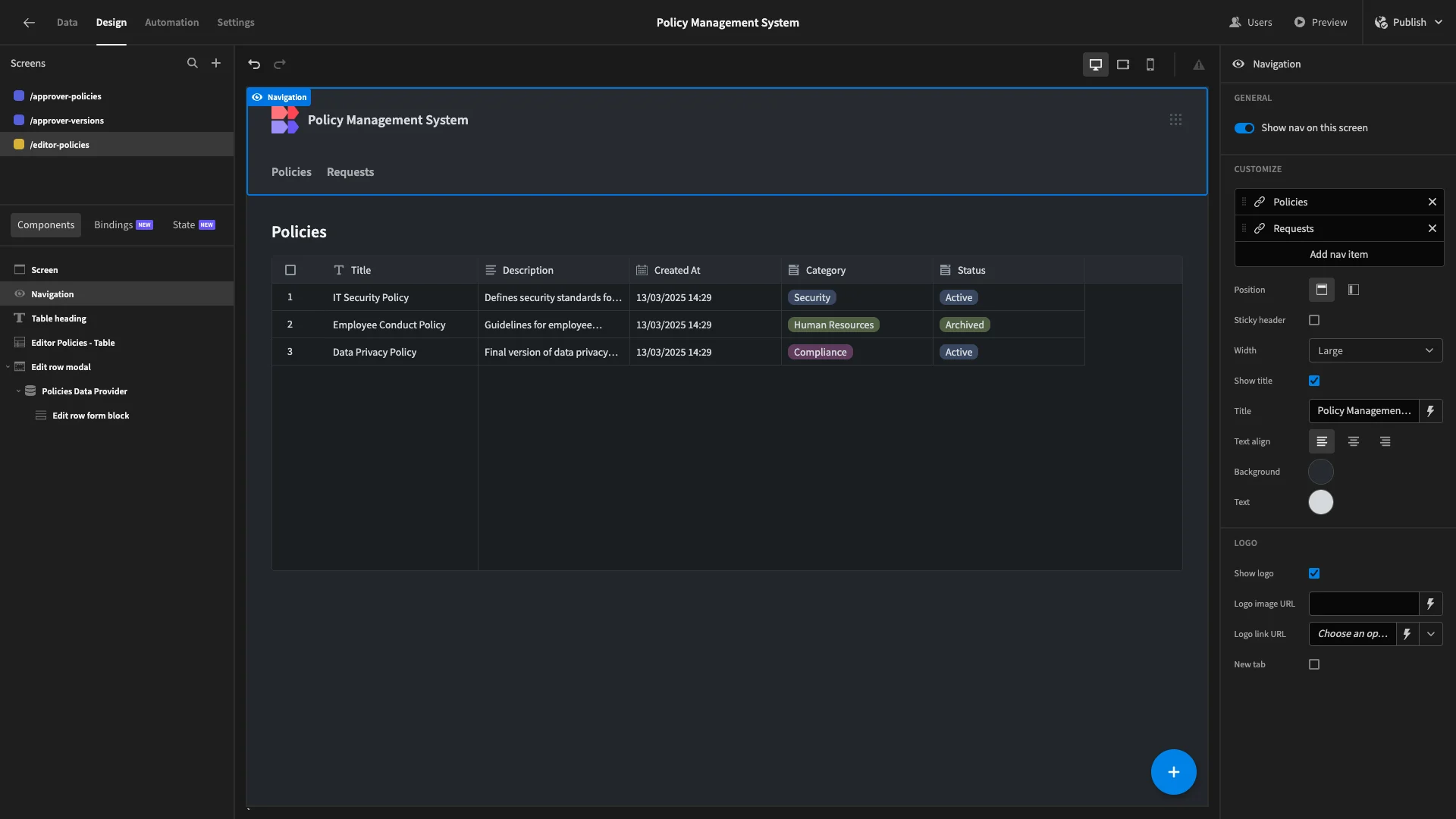
HereÔÇÖs a reminder of what our finished app looks like.
Turn data into action with ║┌┴¤ı²─▄┴┐
║┌┴¤ı²─▄┴┐ is the open-source, low-code platform that empowers IT teams to turn data into action.
To learn more about why organizations of all sizes choose ║┌┴¤ı²─▄┴┐ to build internal tools, CRUD apps, approval workflows, ticketing systems, and more, head to our features overview.